 |
[ Outlaw Genealogy | Bruce
History | Lost Chords ] [ Projects | News | FAQ | Suggestions | Search | HotLinks | Resources | Ufo ] |
 |
[ Outlaw Genealogy | Bruce
History | Lost Chords ] [ Projects | News | FAQ | Suggestions | Search | HotLinks | Resources | Ufo ] |
An important aspect of the Outlawe history in Ireland is Sir Roger Outlawe of the Order of St. John Hospitallers , later the Justice of Ireland. A requirement for a knight of the Order and for the justice of Ireland would be to be of NOBLE BIRTH.
Recent research indicates that Sir Roger Outlawe was born in England to Richard Outlawe in 1260 and had a sister Ida. They lived in Bumstead Helion Essex . This was the center in England for Templars and Hospitallers and crusading families.
William Outlawe of Kilkenney is refered to as Roger's brother, yet Roger lives over twenty years longer then him, So it is more likely that he was his Uncle . This would be likely as the family had an early connection to the Invasion of Ireland.
Helions Bumpstead - is a small village in Essex located near Haverhill and the Essex/Suffolk/Cambridgeshire borders.
1260 - Roger Utlagh - or Roger Outlawe (c.1260-1341 ) was a born - leading Irish statesman of the fourteenth century and held the office of Lord Chancellor of Ireland. Hospitaller Prior of Kilmainham Ireland
Very important people and families of crusaders and Templar/Hospitaller supporters come together for a rental agreement:
1260 - Witness Richard le Utlawe - Essex - Grant of Rent William de Wateville to John de Vallibus and his heirs of land in Hempstead, Essex witnessed by Sir Nicholas Peche, Sir Andrew de Helyun, Sir Simon Peche, Philip de Codree, John de Bosco, Richard de Kanne, Richard le Utlawe, Hugh de Sanford, Roger de Reymes, Geoffrey de Bello, Simon Clericus - 44 Henry III
1285 - Hospitaller Charter of Ida daughter of the late Richard Utlaw of the five acres of land and half an acre of meadow, with appurtenances. - Roger [ son of Richard ] Outlaw ( of Bumpstead Helion ), Ida daughter of Richard
Whoever wished to be received into the brotherhood, was required to prove his nobility for four descents, and that by his mother's as well as his father's side; to be of legitimate birth, (an exception being made only in favour of the natural sons of kings and princes); to be not less than twenty years old; and, in moral character, blameless
The Knights Hospitaller - Helen Nicholson - Knight-brothers of the order had to be a knight or son of a knight and born legitimately of a noble family (one generation) - by 1270's all higher offices were reserved to the Knight-brothers - So who was Sir Roger Outlawe's father?
Outlawe - Ireland Timeline
--- > Earliest Outlaw Rune Stone in Geatland Småland:
700~1000AD - Útlagi
placed this stone in memory of Sveinn -Rune sm103 - Småland
957 - Outlawe(s) Banished
to Ireland by King Edwy - St. Dunstan Banished
( they most likely went to Leinster )
964
-
King Edgar's (Atheling) long connection to the Norse King's
of Leinster and Dublin Ireland: Antuiquity,
name and inhabitants of Dublin ...
The next antient authority concerning Dublin, is king
Edgar's charter, called Oswald's-law, dated at Gloucester in the year 964;
the preface to which runs thus in English:
"By the abundant mercy of God, who thundereth from on high, and is King of kings, and Lord of lords, I EDGAR, king of the English, and emperor and lord of all the kings of the islands of the ocean, which lie round Britain, and of all the nations included in it, give thanks to the omnipotent God, my King, who hath so greatly extended my empire, and exalted it above the empire of my ancestors, who though they obtained the monarchy of all England, from the reign of Aethelstan, who, first of all the kings of the English, by his arms, subdued all the nations inhabiting Britain, yet none of them ever attempted to stretch its bounds beyond Britain. But divine Providence hath granted to me, together with the empire of the English, all the kingdoms of the islands of the Ocean, with their fierce kings, as far as Norway, and the greatest part of Ireland, with its most noble city of Dublin; "all which by the most propitious grace of God, I have subdued under my power."
---- > First evidence of Utlage is a Rune in Geatland Västergötland,
Sweden :
990~1010AD - Utlage
raised this stone in memory of Eyvindr, a very good thegn -
Rune vg62 - Ballstorp, Edsvära, Västergötland, Sweden
1051 - In October Godwin and the rest of his sons were declared outlaws and given five days to leave the country. The men of Dover were left unpunished. Godwin, his wife Gytha, and his sons Swein, Tosti and Gyrth boarded ship at Bosham and left for Flanders. Harold and Leofwine Godwinson sailed from Bristol for the Norse stronghold of Dublin in Ireland.
1052
- Earl Harold (Godwin) is banished to Ireland - During Harold's
time with the Diarmid, the king (King of Leinster - Ireland), possibly
with help from the Godwinsons and their followers, expelled the
Norse-Irish King Eachmargach from Dublin and replaced him with his son,
Murchad. Dublin was
full of Viking mercenaries, and the new king allowed the Godwinsons to
freely recruit them for the coming struggle with King Edward.
1066
- The surviving sons of King Harold
Godwinson of England escaped to Leinster after the Battle
of Hastings in 1066 where they were hosted by Diarmait. In 1068 and
1069 Diarmait lent them the fleet of Dublin
for their attempted invasions of England.
- there may have been as many as 3,000 royal housecarls (the Þingalið)[15].
As the household troops of Harold
Godwinson, the housecarls had a crucial role as the backbone of
Harold's army at the Battle of Hastings.
1068-1069-1082 - The Sons of Harold - Godwine and Magnus Godwin(son), made a number of attempts at invading England in 1068 and 1069 with the aid of Diarmait mac Mail na mBo. They raided Cornwall as late as 1082, but died in obscurity in Ireland.
1072- Diarmait
mac Maíl na mBó - (died 7 February 1072) was King
of Leinster and a contender for the title of High
King of Ireland.
Diarmait belonged to the Uí
Cheinnselaig, a kin group of south-east Leinster
centred around Ferns.
Kings of Leinster were in a particularly advantageous position to exploit this
new wealth as three of the five principal towns lay in or near Leinster. In
Leinster proper, in the south-eastern corner dominated by the Uí Cheinnselaig,
lay Wexford.
To the west of this, in the smaller kingdom
of Osraige, which had been attached to Leinster since the late 10th century,
was Waterford.
Finally, the most important Viking town in Ireland was Dublin,
which lay at the north-eastern edge of Leinster.
1109 - Members
of the Crusade - Robert of Baskerville - 1109 , Hervey of Glanvill -
Second Crusade 1147
1166 - Dairmait
Mac Murchada the King of Leinster sailed to Britain and met with King Henry II
of England... Mac Murchada then travelled to Bristol, where he
recruited the Earl of Pembroke, Richard FitzGilbert de Clare (better known
as Strongbow) as well as a handful of lesser Anglo-French barons
including Robert FitzStephen, Richard FitzGodebert, Maurice FitzGerald,
Raymond le Gros and Milo de Cogan. (See a note on
Norman names.)
1166 - August,
1166, Robert Fitz-Harding of Bristol entertained Dermot MacMurrough,
King of Leinster, his daughter, Eva, and sixty of his followers at a feast
in Bristol
1167 - Pre-Invasion
- 1167 - Dermot MacMurrough and Flemings under Richard
FitzGodebert
First Utlage record ---- > 1169 - Walter Utlage -
Glanville - Bromholm Priory - Norfolk
1150~1169 - Bromholm Priory
- House of Glanville
- Charter of Bartholomew
de Glanville To Bromholme Priory - Walteri Utlage - Et
duas partes decimarum meorum hominum: scilicet avunculi mei Rogeri de Bertuna:
Et Galfridi presbiteri de Honinges: et Turstani despensatoris: et Warini de
Torp: Et Ricardi Hurel: et Walteri Utlage: et Roberti de Buskevill:
et decimam totam Ricardi filii Ketel. - 120 years later we find Jose
de Keteler and William Outlawe involved in the (Templar?) "Banking
business" and Roger Outlawe prior of Kilmainham. - Roberti de
Buskevill - Robert of Baskerville
( I include this as the earliest Utlage record found and Ricardi
filii ( son of the ) Ketel may be an early form of Keteller or Kyteler also included
in this charter are the de Burgs and other notables. This creates a link between
a pre-norman invasion of Ireland and post. Also note Glanville and others
connected with this Priory were involved with the Templars and Crusades)
1169 - Norman Invasion of Ireland Begins - (Earl of Pembroke Richard DeClare) Strongbow who led the initial invasion of Ireland - 1 May 1169 Main body of Norman, Welsh and Flemish forces landed in Wexford , f near Bannow, County Wexford. This was at the request of Dermot MacMurrough (Diarmait Mac Murchada), the ousted King of Leinster who sought their help in regaining his kingdom.and with the approval of Henry II, - Topic
1169 - Bannow Island, Wexford - 1st landing 1169 - Robert FitzStephen
1169 - Bannow Island, Wexford - 2nd landing 1169 - Maurice de
Prendergast
1169 - Wexford - 3rd landing 1169 - Maurice FitzGerald
1170 - Baginbun, Wexford - 4th landing 1170 - Raymond le Gros aka Raymond
Fitz Gerald
1170 - Passage, Waterford - 5th landing 1170 - Richard Strongbow de
Clare
1170 - Strongbow
married Dermot's daughter Aoife
of Leinster
1171 - King
Henry II lands in Ireland with
a large fleet at Waterford,
becoming the first King
of England to set foot on Irish soil - Randulph de
Glanville was a witness to the Dublin Charter
1171 - King
Henry II. went over to Ireland, Bartholomew de Glanville, Wimar the
chaplain, and William Bardul render their account for 320 hogs sent to
the army in Ireland
1171 - Henry II
landed a much bigger force in Waterford and took control of Ireland with a larger second invasion on the 18th October
1171. This was to ensure his control over Strongbow.
- Crook, Waterford - 6th landing 1171 - King Henry II
1171 - The
people of Bristol were given Dublin as a colony by the king and many
Bristolians settled there. Charter
was issued by Henry II in 1171-1172, giving the men of Bristol the
right to live in the City of Dublin. Later charters contain grants
to the city of rights, privileges and property
--->>>> first Outlawe record in Ireland
- Dublin:
1172 - Torsten
utlag - Reginaldus utlag - Dublin Roll of Names
- (First Utlag record in Ireland - Ostman or
Englishman?)
1174 - Priory of Kilmainham was erected on
the site
of Kilmaignend by Richard (de Clare)
Strongbow, 2nd Earl of Pembroke for the. Knight's
Templars dedicated to St. John
1175 - Treaty of Windsor
, made with Ruaidrí mac Tairrdelbach Ua Conchobair (often Anglicised Rory O'Connor the King of
Connaught), Henry II became the High King of Ireland. This Treaty resulted in large scale emigration from England to Ireland and 800 years of English control of Ireland.
1180-1199 - Torsten
Utlag - Burgess - Dublin Ireland
1183 - The
Order of the Templars in Ireland is confirmed. The Abbey Legis Dei, that is of Leix, is
founded.
1185 - Clerkenwell
Priory - Order of the Knights
Hospitallers of St
John of Jerusalem - church was consecrated by the Patriarch
of Jerusalem, Heraclius
1185 - King
John's first expedition to Ireland - John at this time engaged in a vigorous
program of extending land grants to trusted royal administrators such as Theobald
Walter, William
de Burgh, Gilbert
Pipard and Bertram
de Verdun as well as other minor land grants to lesser figures. ...men
like Walter would breed a new family generation — the Butlers
— who would in time come to be an influential part of Ireland's history.
1186~1202
- Confirmation
by the Prior of St. James's, Bristol, to John, son of Ralph
Utlage, of land in Lewin's Mead
1200~1210 - Grant
by the Prior of St. James's, Bristol, to Margam Abbey, of land in Lewin's
Mead, Bristol, Formerly held by John, son of Ralph le Utlage
1207 - Hubert de Burgh purchased of Roger de Burnham and Julian, his wife, William de Noiers, Robert Fitz Ralph, and Alice his wife, and Robert de Utlagh, their several nine parts of two knights fees in Runton and Beeston and Hinderingham, for which they paid castle gaurd to Dover. 9th of King John *The Norfolk antiquarian miscellany - Google Books - West Runton - Beeston Regis - Hindringham
1210 - King John came with a fleet and a great army into Ireland, and drove from the country the sons of Hugh Lacy, Walter, Lord of Meath, and Hugh, for they had tyrannized over the common people, and had killed John de Courcy, Lord of Kilbarrock and Rathenny, Co. Dublin, because he had complained of them to the King; but they fled into France, and remained for a long time unknown in the Abbey of St. Taurin, serving in menial employments, to wit, in the garden digging and preparing mud and bricks; but at last they were discovered by the Abbot, and at his entreaties reconciled to the King, and having paid a great sum of money were restored to their former authority in Ireland
1210 - Margam Abbey - John, son of Ralph Utlage, of the land in the meadow of Leowine, known as Lewin's-mead, near to St. James' Church, Bristol. - dated in the early years of the thirteenth century. - Cartae et alia munimenta quae ad dominium de Glamorgancia pertinent Clark, George Thomas - this record included due to Bristol's connection to Ireland and the English conquest.
1215 - Geoffrey de Marisco founded a Commandery of the Knights Hospitallers at Hospital - parish of Aney Ireland - Hospital, County Limerick
1220 - Officially the Templars arrived in Ireland in September 1220
1227 - Hubert
De Burgh - Lord Justice of Ireland
1243 - Death of Hugh
de Lacy, Earl of Ulster, Death of Gerald Fitz Maurice and of Richard
de Burgh.
1257 - Death of Maurice
Fitz Gerald.
1264 - Maurice Fitz
Gerald and Maurice Fitz Maurice took prisoners at Castle Dermot, Richard
de Capella, Justiciary, and Theobald Butler, and John Cogan.
1271 - Pestilence,
famine, and the sword in Ireland, and chiefly in Meath; Death of Walter de
Burgh, Earl of Ulster
1272 - Maurice
Fitz-Maurice Fitzgerald - elected Lord Justice of Ireland
1274 - William
Fitz-Roger,
Prior of Kilmainham, was taken Dublin prisoner by the latter in a
battle fought in 1274
1279 - June
12 Rochester - Simple Protection, for three years, for David de
Pembrok, and Cecil[ia] la Utlaghe - Kings Writ - 7 Edward I
( every indication is that Cecilia Utlaghe was from Ireland along with
David de Pembrok and in England for schooling )
1280 - Dame
Alice Kyteler was born at Kyteler's House, Kilkenny, where her
father carried on a banking business
1280 - Jose
de Keteller father of Alice Kyteller died - Alice Kyteller was about 10 years
old - Alice
Kyteler's father died , Alice, who was an only child, inherited his business
and properties
1285 - Hospitaller Charter of Ida daughter of the late Richard Utlaw of the five acres of land and half an acre of meadow, with appurtenances. - Roger [ son of Richard ] Outlaw ( of Bumpstead Helion ), Ida daughter of Richard ( Hospitallers Cart. Maplestead Preceptory )
1288 - William
fitz Roger was Prior of Kilmainham - Preceptory of the Templars
1290 - A deed
mentions Hugh de Utlagh holding property in New Ross Wexford
Ireland, in the "Street behind Market Street". -
Hugh de Utlagh
was a citizen of New Ross on the borders of counties Kilkenny and Wexford.
1291 - Letters for Robert de Scales, going beyond seas, nominating Robert le Waleys and John le Blund his attorneys until three years after Midsummer.
The like for :
Margery de Pembrok, staying in England, nominating Walter de Bodenham in Ireland for one year.
David de Pembrok as the preceding. April 21 - Newcastle-on-Tyne - 19 Edward
I
1291 - Margery de
Pembrok, staying in England, nominating Walter de Bodenham in Ireland for one year.
David de Pembrok as the preceding. April 21 - Newcastle-on-Tyne
1296 - 'Sussex subsidy of 1296:
The rape of Arundel', Villat' de Madhurst, Tortingeton, et Bynstede - Willmo le Utlagh
- Madehurst - Tortington
- Binsted
(Possible connection to William Outlawe Sr. in Ireland?)
1297 - Reginald
de Buittauont received Gilleroth OBrenan; and Reginald eat sheep of
Rob. Eynoc in his house, and he took half a crannoc of
oats of Berkhoe the goldsmith. And Ph. le Gret, Nich. Fyn, David
OCounscich, Will. Dagon, Will. Utlagh, and Ilger Granecan, robbed
the town of Ric, Boy, to the value of 4s. Fled. Outlawed.- 25-26
EDWARD I. Page 180 - CALENDAR JUSTICIAEY ROLLS OR PROCEEDINGS IN THE
COURT OF THE JUSTICIAE OF IRELAND - 1295-1303 Edward I 23-31
1298 - Dame
Alice Kyteler marries William Outlawe brother
of Sir Roger Outlawe, soon to be Chancellor of all Ireland
Her family came to Ireland after the Norman conquest of 1169
1299 - William
Outlawe was twenty years older than Dame Alice when they married in 1299. She
bore a son for him a year later whom they called William junior.
1300 - William
Outlawe (Junior) is born.
1301- Lord Mayor of Kilkenny -
William Outlawe
1302? - William
Outlawe Sr. died
suddenly under mysterious circumstances
1302? - Months later, Dame Alice marries her second husband, another
banker from Callan, named Adam Le Blond . It is believed she
had a daughter by Le Blond whom they called Basilia (or Roesia
Outlawe)
1308 - Witness
William Utlawe of Kilkenny - Quitlaim of the manor of Knocktopher
- Walter de la Haye, knight
1308 -
The heavily indebted Phillip IV of France accused the Knights Templar of
heresy in 1307, had the leaders thrown into jail and orchestrated a show
trial.... After the events in Paris, On 10th January1308, the
Knights Templar in Ireland were arrested and placed in Dublin Castle. Between
fifteen and thirty knights were taken, most having seen more than forty years of
service with the order. Basically Ireland seems to have been the pensioner's
home of the order. - Topic
1309 - Gerald
fitz Maurice,
Lord of Kerry, the last Grand Prior of the Order (of St.John Templars)
- FITZMAURICE Norman, Welch, and Legendary Ancestors
1310 - Trials
against the Templars commenced in January in Saint
Patrick's Cathedral - accusations based on hear-say flew at the knights, but
no evidence could be found and no confessions were forthcoming. The trials
ultimately fizzled out, ending after six months in an anti-climax. The Templars
were admonished to be good Christians and pensioned off. The property of the
Knights Templar in Ireland was either taken by the crown or transferred to the
Hospitallers
1310 - Dame Alice was once again a widow as Le Blond died after a ‘drinking
spree'.
1310
- Thomas de
Cantewelle, Knight, Edmund le Gras, William fitz Edmund le Gras, John fitz Simon
Shorthals, Roger de Wauncy, and others, were securities to Richard de Valle and Alice
Keteller, his wife (formerly wife of Adam le Blound, of Callan), for the payment of 200 marks, loaned by the said Richard and Alice to
William Utlawe of Kilkenny. - Feb 13
1310- Lord Mayor of Kilkenny - William Outlawe
1311-1340 - Sir Roger Outlawe - The Grand Prior - Hospital Of Saint John Of Jerusalem In Ireland - Priory of Kilmainham - Lord Justice of Ireland
1311 - Dame Alice marries her third husband. He was a wealthy landlord
who owned extensive properties in and around Clonmel. His name was Richard De
Valle (or 1310 see above)
13?? - It seems Richard De Valle grew suddenly ill while in the
prime of life and died after a sumptuous supper.
1311-12 - Lord Mayor of Kilkenny - Henry Outlawe - chief magistrate was known as the Sovereign Henricius Owtlawe 1312
1313 - Willielmus Outlagh
- The Tallage of 6 Edward II - Bristollia Bristol - Tallage
- Bristollia or, memoirs of the city ...
(Bristol to Ireland connection again)
1316 - Battle of Kells
- Edward Bruce - Lord
Edward Bruce takes possession of the town on Palm Sunday on his way to
defeating the forces of Lord Justice Edmund le Botiler (Butler).
- Kells Priory
- Attacked
and burned by the Scots army of Edward
Bruce on Palm
Sunday (Kells was "owned" by the Le Poers.)
1316 - Roger Outlaw became Prior of
Kilmainham
1317 - Roger Outlaw
was granted the fee-farm of Chapelizod. Which was then added to the lands
of the monastery. Also in 1317 Outlaw convened a Parliament at Kilmainham
at which he secured the release of Richard De Burgo, Earl of Ulster who
had been imprisoned by the Mayor and Commons of Dublin on suspicion of aiding
the Scottish invasion of Ireland by Robert de Bruce.
1317 - Irish famine - Great Famine of 1315–1317
- Starting with bad weather in spring 1315, universal crop failures lasted
through 1316 until summer 1317; first of a series of large scale crises that
struck North
Europe early in the fourteenth century, causing millions of deaths over
an extended number of years
1318 - Roger Outlaw was
made Lord Treasurer of Ireland
where upon he bound himself and his successors to pay £300 a year to the
Archbishop of Dublin to exercise Episcopal jurisdiction in Rathmore and
neighbouring churches
1318 - Edward Bruce
- 14 October 1318, the Scots-Irish army was badly defeated at the
Battle of Faughart by de Bermingham's forces. Edward was
killed, his body being quartered and send to various towns in Ireland, and his
head being delivered to King
Edward II. - He is buried in the churchyard on the Hill of Faughart
on the Cooley
peninsula near Dundalk,
Co.
Louth.
1320 - Dame Alice marries her fourth husband . This man was also of
Norman stock as were his predecessors. His name was John Le Poer
1321 - Roger
Outlawe - elected Lord Chancellor of Ireland - Roger
was Lord Chancellor of Ireland in 1321 to 1325, and again, 1326—1330: again,
1333: again (a fourth time), 1335: and a fifth time in 1339 - Roger Outlawe was
Lord Justice, either in his own right or as locum tenens for
others, in 1328, 1330, and 1340, in which last year he died in office
1322 - April
3 - William Utlawe of Kylkenny - loan of as much as he can lend to King Edward
II for war against the Scots at Carlisle
1323 - John Le Poer
found himself suffering from many different sicknesses.
Although he was only middle-aged, he became feeble and slow. His hair fell out
in patches and what remained turned silvery grey and his finger nails fell out.
He dies in 1324. - Was he a relative of Lord Arnold Le Poer?
1324 - Dame
Alice Kyteler was
charged with heretical sorcery escapes to England with help from Brother-in-law Sir
Roger Outlawe
1324 - Dame
Alice and her disciples were condemned to be whipped through the streets, tied
at the back of a horse and cart after which Alice, as chief priestess and
instigator would be burned to the stake.
-
But by the political power of the Chancellor of all Ireland, her former
brother-in-law Roger Outlawe, her escape was organised. Her guards were
beaten senseless and Dame Alice was released from the dungeons beneath Kilkenny
Castle and freed from the sentence of death that hung over her. Dame Alice
had begun a new life in far off London, never again to set foot in her
native Kilkenny.
1324 - "William Outlaw
was supported by Lord Arnold de Poer, Lord of
Kells who arrested the Bishop Ledrede and had him imprisoned in Kilkenny
Castle for 17 days."
- As the Bishop was going forth ... he was met on the
confines of the town of Kells by Stephen le Poer, bailiff of the
cantred of Overk, and a posse of armed men, by whom he was arrested under orders
from Sir Arnold, and lodged the same day in Kilkenny jail..
1324 - Dame
Alice Kyteler - her goods and chattels should be confiscated (this apparently was done on 2 July 1324)
1324 - On
orders of Bishop de
Ledrede, Petronilla was condemned to be burnt alive
and the sentence was carried out ‘with all due solemnity’ in Kilkenny on Sunday, 3 November 1324.
1324 - William Outlawe nephew of Sir Roger Outlaw is ordered to make pilgrimage to the Shrine of St. Thomas at Canterbury
1324 - Summons
to Thomas Fitz John Earl of Kildare to the war in Aquitane -
Similar summonses were sent to William Utlawe
of Kilkenny - 18 Edw. II 30 Oct. (Aquitane)
- Westminster,
30 Oct. - Lambeth Palace Library. - 18 Edw. II., .Summons to Thomas Fitz John Earl of Kildare
to the war in Aquitane; sent by John Darcy, Justiciary of Ireland, and Nicholas, Fastolf, Chief Justice "ad placita proefatum Justic. sequentia." Westminster, 30 Oct.
Similar summonses were sent to Maurice Fitz Thomas, Thomas le Botiller, William de
Burgh, John de Barre, Arnold le Poer, John le Poer Baron de Donoyll, Richard de Maundeville, Walter de Cusak, Nicholas de Verdun, Richard de Tuyt,
George de Roche, Maurice de Rochfort, William de Caunceton, Thomas de Dene, Reymond L'Ercedekne, John FitzBenedict le Poer, William de Bermyngham, Hugh Laghle, Alan Fitz Warin, Richard de Bermyngham, Walter de Valle, William de London, Miles de Cogan, Henry de Roche de Routhre, William Haket, Simon de Genevill, Lionel (?) FitzStephen, Robert le Sauvage, Walter Wogan, John de la Rokele, Herbert de Marisco, Richard le Waleys, Henry de Vernoil, John de Bermyngham, Earl of Louth, the Archbishops of Dublin, Armagh, Cashel, and Tuam, the Bishops of Ossory, Cork, Lismore, Kildare, Coyners (Connor), Down, Fernes, Meath, and Limerick, Walter de Cusak, Robert Trussell de Ros,
William Utlawe of Kilkenny, Matthew de Bath of Drogheda, John Galegre of Cork, Robert de Notyngham [of] Dublin, William de Clebury, parson of the Church of Trymm
1326 - Roger
Outlawe - elected Lord Chancellor of Ireland - again
1326 - A deed was enrolled in
Chancery made between William fitz Maurice and William Outlawe, by which it was agreed that
Maurice, son and heir of William fitz Maurice, should
marry Margaret, daughter of William Outlawe, Outlawe paying to William fitz Maurice 100 marks of silver
1326 - Margaret
Outlawe - William fitz Maurice
who married Margaret daughter of William Outlawe , the wealthy banker of Kilkenny
- William Fitz Maurice - Williaim fitz Maurice, son and heir of Maurice fitz
Maurice, succeeded his father, and in the extent of the services due to Richard, Earl of Gloucester and Hertford in the county
Kilkenny,
taken in the year 1247 - they are later known as the "Maurice
Fitgerald"'s [ So here we see the Earl of
Gloucester - Outlawe connection which leads later to Bristol -
Hertfordshire(Essex) and Norfolk ]
1327 - Roger
Outlawe, the Prior of Kilmainham, was made Lord Justice for the first time in
1327
1327 - Jan. 20. ROBERT
DE BREUS, as a Banneret. KNIGHTS OF THE BATH
1327 - Jan. 31. The
king, EDWARD III.
KNIGHTS
OF THE BATH
1328 - Roger
Outlawe - elected Lord Justice
1330 - Roger
Outlawe - elected Lord Chancellor and Lord Justice of Ireland - again
1330 - Exemption
for life, of William Utlawe from being put on assisce, juries or
recognisances, and from appointment as mayor, sheriff, coroner or other minister
of the king against his will. March 10 1330
1331 - Lord Arnold Le Poer was arrested, and accused of heresy by Richard Ledrede, bishop of Offory, confined in the castle of Dublin, where he died before he could be tried; and tho' the Lord Justice Roger Outlawe, prior of Kilmninham, made it appear, that Lord Arnold was falsely accused, yet he remained a long time unburied, because he died unaffoiled. - Sir Arnold le Poer was not so fortunate. He died whilst still in prison in 1331 and because he was still under excommunication, his body lay unburied for a long time.
1331 - Shortly
after Sir Arnold’s death, Bishop de Ledrede found himself accused of heresy by a leading churchman, Alexander de
Bicknor.
1331 - Roger
Outlaw commanded an expedition against Brian O'Brian and other
enemies of our lord king in Munster to Athyssel in Tipperary, in which Arnold
Outlawe commanded eleven men at arms and fourty-eight footmen - 4 Edward
III. - Arnold Outlawe was the protégé of Arnold le Poer. - The Normans in Thomond
1332 - William
Outlawe is said to have been Prior of Kilmainham, and lieutenant of John
Lord Darcie, Lord Justice.
1332 - David de la Roch is
included in a group of Knights and Squires mentioned in a letter from King
Edward III to the Archbishop of Cashel stating that Roger Outlaw, Prior of
the Hospital of St, John of Jerusalem in Ireland, has been given the power to
treat with both the English and Irish about coming into the King's peace and
favour.
1333 - Aug 4 - Power for
Roger Outlawe, prior of St. John of Jerusalem in Ireland, to treat with the Irish rebels, and receive them into the K.'s peace.
.
1333 - Aug 4 - The K. desires the
archbp. of Cashel, William de Burgh, earl of Ulster, and 14 others, to assist Roger de Outlawe in his treaty of
peace.
1333 - Roger
Outlawe - elected Lord Chancellor - again
1335 - Roger
Outlawe - elected Lord Chancellor - again
1335 - William
Outlawe. - Names of Persons summoned to attend John Darcy, Justiciary,
with arms and horses in his Expedition to Scotland
1336 - Grant, for life, to William son of Nicholas Utlawe that his houses in cities, boroughs and other places in Ireland shall be quit of livery of the king's justices and ministers there, that none of these shall make any livery or lodge in them against his will. Also that nothing shall be taken by them of the victuals and goods of him or his men in that land for the king's use against his will or without due satisfaction. By K. - July 10 Perth
1338 -
Pardon, in consideration of his service to Edward II.
and the king, to Roger Outlawe, prior, and the brethren of the Hospital of St. John of
Jerusalem in Ireland for appropriating without licence, to them and the convent of that order at
Kilmaynam, the church of Kilcanegan, extended at 100s. a year, and the church of
Moyrath, extended at 40s. a year and of their advowson, and grant that they may hold these so appropriated.
By K. and by fine of 10 marks. Ireland - May 24 Tower of London
1338 - The King rewarded
Roger Outlaw for his long service and loans of money with custody of the
manor at the Salmon Leap in Leixlip.
1339 - Roger
Outlawe - elected Lord Chancellor of Ireland
1340 - Roger
Outlawe - elected Lord Justice of Ireland - again
1340 - Seal - William Utlage - Used by Robert of Durham, merchant.- Inscription: SIGILLVM WILELMI VTLAGE - Seal design: Round, armorial, a lion rampant. - pdf see Isle_of_Ely_page (Looks like a Order of St. John Hospitallar signature seal) Durham - ( Hard to tell what this record is about William Outlawe dies in Durham?)
1341 - Roger Outlaw, still Prior, Chancellor and Lord Justice of Ireland died at Aney (Knockainy Co. Limerick)
1342 - William
son of William Outlawe
grants to Johanna, who was the wife of William Outlawe -
Kilkenney
1347
- Dec. 25. PHILIP
DE STAUNTON. - KNIGHTS OF THE BATH - Full text of The Knights of England.
1362
- Maurice
Purcell grantes to Nicholas Broun, chaplain, vicar of the church of Mothyll,
Henry Osmer, chaplain, vicar of the
church of Jerpoint,
Roger son of William
Outlawe
and Dauid son of John fitz Nicholas the advowson of the church of Fynel
as above. Given at Fynel. Witnesses: Robert Marescall, cleric, Nicholas
Syfert, cleric, Maurice Deuenys, William Ley and Thomas Broun of Higginstowne.
[#798, p.337-8] February 1, 1362
1362 - church
of Jerpoint,
Roger son of William Outlawe
1382 - A William Outlawe appears on the Pipe Rolls in Maeth, 6 Richard II 1382
It is interesting that this timeline in Ireland seems to end here in the late 1300's for the Outlawe's and the Kyteler's.
1586 - Owltagh (Ultagh), Brian de Clondolch - Dublin - COURT BOOK OF THE LIBERTY OF SAINT SEPULCHRE WITHIN THE JURISDICTION OF THE ARCHBISHOP OF DUBLIN, 1586— 1590
1590 - Robert Outtlawe de --- Jurator - Dublin - COURT BOOK OF THE LIBERTY OF SAINT SEPULCHRE WITHIN THE JURISDICTION OF THE ARCHBISHOP OF DUBLIN, 1586— 1590
| - - - - - -
It seems that the sons/daughters of the Outlawe's of William
Outlaw Jr, -> William / Arnold / Robert / Margaret and the Kyteler's left
for England (Although Margaret carries on with the FitzGerald's) .
Maybe they stayed in Ireland and they were no longer of any historical note. The
timeline for the most part continues back in England and in the Norfolk area.
The history of Ireland, ancient and modern Derived from our native annals ... - Martin Haverty
* Great commotion was excited among the Anglo-Irish in 1325, by the prosecution of a respectable woman, named Alice Kyteler, for witchcraft, in Kilkenny. She had married four husbands, and the last of these, with some of her children by former husbands, were her chief accusers. She had accumulated enormous wealth, all of which was conferred on her favorite son, Robert Outlawe; and by the aid of powerful friends, among whom were some of the civil authorities, she managed to escape to England. One of her accomplices, named Petronilla, of Meath, who confessed her participation in several acts of foul and impious superstition, was, in compliance with the ideas of the age, burnt as a sorceress. See Grace's Annals; also a Cotemporary Narrative, edited for the Camden Society, by Thomas Wright, 1843.
I must admit this seems strange since I thought the favorite son was William (also Robert could be Roger)? It is interesting that after this commotion we find a Robert Outlawe in Suffolk...
It also might be the "Robert of Bristol"
The Burning Times Tribute
...
The Pope at that time believed that evil spirits could be imprisoned in rings or
mirrors for the purpose of obtaining information about events in either the past
or the future. To stamp out these practices, he ordered the formation of what
was ultimately to become a far greater evil- The Inquisition. The Bishop of
Oxssary, eager to please the Pope, duly had Lady Alice arrested, together with
11 others. These were her son by her first marriage, William Outlawe, Robert
of Bristol, Alice Faber, John,Helen and Syoh Galrussyn, William Payne de
Boly, Eva de Brounestoun, Annota Lange, Petronella de Meath, Alice's maid and
Petronella's daughter Sarah.
THE BURNING TIME
Historical Notes by Robin Morgan
...
The peasants were mostly helpless. Alyce Kyteler was not. Rich and well-connected, she is referred to in the records as a “domina dives” (wealthy noblewoman). She had been widowed three times (William Outlawe, Adam le Blound, and Richard de Valle), and her current husband, Sir John le Poer, was in ill health. He accused her of poisoning him, and found a ready ally in the Bishop, who charged Lady Alyce with seven indictments. (The charges listed in Chapter VII accurately reflect these; indictment number four, for example, was that she and her followers “parodied religious ceremonies, saying ‘Fie, fie, fie, amen!’”).
Kyteler and the Bishop engaged in quite a personal war. She was powerful enough to defy him, so he excommunicated her. She then had him imprisoned by reviving an unsettled charge of his having previously defrauded a widowed parishioner. He retaliated from prison by placing the entire diocese under interdict, but this illegal ban was lifted by highly placed friends of Lady Alyce.
Her supporters included the Lord Justice of Ireland; the Seneschal (Mayor) of Kilkenny, on record as having denounced the Bishop as a “vile, rustic, interloping
priest”; the Archbishop of Dublin, who publicly declared de Ledrede “a truant monk from England”; and even King Edward II and the Crown Prince (later Edward III) of England. Nevertheless, with the Pope’s support, the Bishop persevered, finally convening an Ecclesiastical Court to condemn her.
Lady Alyce was eventually forced to flee to England. There she was befriended by Edward III, who ascended the throne in 1327 and was himself interested in The
Craft; Edward passed antipapal and anticlerical statutes, in 1366 abolishing Peter’s Pence, the tax paid to the papacy by every house in England. Meanwhile, the Archbishop of Dublin brought a charge of heresy against Richard de Ledrede, who fled to Avignon to seek the Pope’s protection. In 1329, Edward III seized the Bishop’s revenues, and de Ledrede didn’t return to England until 1348. But he remained under ostracism until 1354, and six years later he died in disgrace.
Of those accused with Kyteler (see below), some were killed, some whipped through the streets to the marketplace where crosses were burned into the remains of their flesh, some banished and sentenced in absentia to excommunication--which probably means they had already escaped.
The fates of only two are known for certain.
William Oultawe, Alyce Kyteler’s son by her first husband, was imprisoned for nine weeks and
fined. He was then allowed to recant and receive Church sacraments, on condition that he make a pilgrimage to the Shrine of St. Thomas at Canterbury, and pay for the re-roofing in lead of St. Canice’s--today called St. Mary’s--Cathedral in Kilkenny Town. (Modern Kilkenny residents still wink at the witchly irony that this penance caused the too-heavy roof to cave in, as described in Chapter XVII.)
The records also show that Petronilla de Meath, a member of the Kyteler household, was flogged six times. She confessed to sorcery and all charges of the Bishop’s court. Once certain that Kyteler had made a successful escape together with de Meath’s daughter Sara (sometimes listed in the records as Sara Basilia), she named Kyteler--but only Kyteler--as an accomplice. Refusing to name any others, she scorned the sacraments of the Church, and was declared apostate, excommunicate, and damned. She was burned alive at the stake in the marketplace of Kilkenny Town on November 3, 1324.
Petronilla de Meath was the first person ever to be executed for witchcraft in
Ireland. With her death, the Wiccans of Eire knew that The Burning Time had arrived in the land of The Old Ways.
1327 - Robert
Outlawe in the Subsidy Tax rolls of the county of Sussex
1180-1199 - Torsten Utlag - Burgess - Dublin Ireland (First Utlag record in Ireland - Ostman or Englishman?)
The English historical review, Volume 23 edited by Mandell Creighton
The English and Ostmen in Ireland
AS is well known, the adventurers of Norman and English blood who landed in Ireland in the years 1169-1170 found themselves confronted not only by the Celtic natives, but also by a race who, like themselves, were Teutonic in blood and as colonists and invaders had preceded them by but a few hundred years. These were the descendants of Norwegian and Danish settlers who had blended now into a race, called by the generic name of Ostmen, both among themselves and by the English.1 This race was practically an urban one.
The Ostmen held five cities which they had founded, and within whose walls they lived the lives of merchants, sometimes varied by acts of piracy, those cities being Dublin, Waterford, Limerick, Wexford, and Cork. . The first three were governed by petty kings, but it is uncertain whether the last two had dynasties of their own. Yet their colonies were not exclusively urban.
The Dublin Ostmen had an
indefinite rule and colonies extending over a district roughly corresponding to
the modern county Dublin, stretching west to the modern Leixlip, the name of
which indicates in Norse' Salmon-Leap,' south to Wicklow, and north over a
much wider area extending to the borders of Meath, called by the Irish
themselves Finegall, or ' boundary of the foreigners.' The whole formed a
small kingdom, called in the Icelandic Landnamabok 'Dyflinarski.' Waterford, a
walled city
...
The circumstances of the conquest of these towns are well enough known. It is
sufficient to say that by the year 1200 all of them were in the hands of the
English. What now happened to the Ostmen? It
is probable that of this powerful and numerous race the greater part sailed off
to the free Norse-land which remained in Man and the Scottish islands. Others, perhaps,
went over to England to practice maritime trades. The pilots of the English
seaports are called Esturmanni in the documents of the thirteenth century. This
itself is most certainly a Scandinavian word, implying ' steersmen,' and
the pilots were probably mainly of Northman stock.2
Here then was an occupation to which many of the Ostmen could
turn. Those who remained were in the main practically excluded from those
privileges, legal and commercial, which the English brought with them, though
they received some favour not shown to the Irish.
The advantage to the English colonists of treating the older race as outlaws
is obvious. They were the better enabled to do this successfully because, to the
superficial eye of the law, the Ostmen were hard
to distinguish from the rightless Irish. Separated from the great Norse world,
few in numbers, the original Norsemen of Ireland had become in the course of
three centuries more than half Hibernicised. It is evident that intermarriage
between Irish kings and Dublin or other Northman princes had been complicated
and numerous during the tenth and eleventh centuries, and the advantage was all
on the side of the natives.
...
A further feature of the treatment of the Ostmen was
their exclusion from gilds and burgess rights. As we see the numbers of this
people must have been considerable, considering how few at first the English
themselves probably were. In Waterfond Philip mac Gothmond had ' 400 of his
race' about him. In the early part of the thirteenth century there were in the
county Wexford a hundred freeholders of this race, with their families; and yet,
if we went by burgess rolls only and lists of the members of gilds, we should
be almost left ignorant of the existence of a surviving Ostman race. It is
clear that the English townsmen at once rigorously excluded these born traders
from all participation in gild and borough rights.
In the earliest burgess roll of Dublin, which dates from about the end of the twelfth century, out of many hundreds of names only three seem to be of Norse origin; these are Cullin filius Seafani, Torsten utlag, and Turstein filius Simundi
Glanville - Outlawe - Ireland Connections - Theobald Walter, the first Butler of Ireland
1169 - Bromholm Priory - House of Glanville - Charter of Bartholomew de Glanville To Bromholme Priory - Walteri Utlage - Et duas partes decimarum meorum hominum: scilicet avunculi mei Rogeri de Bertuna: Et Galfridi presbiteri de Honinges: et Turstani despensatoris: et Warini de Torp: Et Ricardi Hurel: et Walteri Utlage: et Roberti de Buskevill: et decimam totam Ricardi filii Ketel. -
120 years later we find Jose de Keteler and William Outlawe involved in the (Templar?) "Banking business" and Roger Outlawe Prior of Kilmainham. - Roberti de Buskevill - Robert of Baskerville
Records of the Anglo-Norman House of Glanville from A.D. 1050 to 1880 - Pages 1 to 20
In 1171, when King Henry II. went over to Ireland, Bartholomew de Glanville, Wimar the chaplain, and William Bardul render their account for 320 hogs sent to the army in Ireland £26 16s. 5d., 15 days' pay to 36 masters and 468 equippers £33 13s. 0d., making bridges, hurdles, and other ship's apparel £6 5s. 5d., 6 handmills and their appendages 14s. 4d. This account was paid to them by the King's Writ. (Pipe, 17 H. II., Bot. 1.)
Records of the Anglo-Norman House of Glanville from A.D. 1050 to 1880 - Preface and Introduction
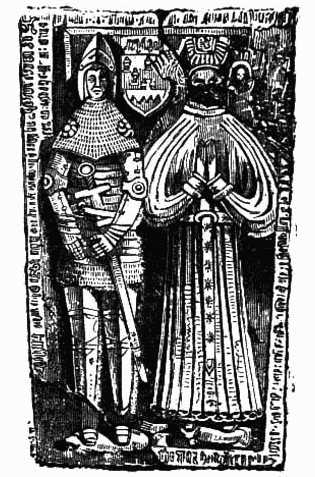 A very interesting question is mooted in this book as to the origin of
Theobald Walter, the first Butler of Ireland, the ancestor of the great family of
Ormonde. Mr. Glanville-Richards claims him for a member of that family, whilst Lord Arthur Hervey, the present Bishop of Bath and Wells, has, in a paper read before the Suffolk Archaeological Institution, as firmly annexed him to his own. It is worth while to weigh the pretensions of the rival claimants.
A very interesting question is mooted in this book as to the origin of
Theobald Walter, the first Butler of Ireland, the ancestor of the great family of
Ormonde. Mr. Glanville-Richards claims him for a member of that family, whilst Lord Arthur Hervey, the present Bishop of Bath and Wells, has, in a paper read before the Suffolk Archaeological Institution, as firmly annexed him to his own. It is worth while to weigh the pretensions of the rival claimants.
It should be premised that the older Heralds assert that Theobald Walter was a great-nephew, or some say cousin-german, of Strongbow, Earl of Clare.
[fn 3]
It may also be as well to mention as an undisputed fact that Theobald Walter was nephew of the Lord Chief Justice Glanville, or rather of his wife, the Lord Chief Justice and one Hervey Walter, his father, having married sisters, the daughters of Theobald de Valoins, from whom probably was derived his name of Theobald, though possibly there was another reason for it.
Mr. Glanville-Richards claims that Hervey Walter and the Chief Justice were brothers - this has to be proved. It was also undoubtedly through the Lord Chief Justice, and not through the influence of the Clare family, that Theobald Walter set foot in Ireland. (All facts in favour of the contention of Mr. Glanville- Richards.)
We read at pages 33-4 that when King Henry invested Prince John with the government of Ireland, the Lord Chief Justice accompanied him, and that Prince John by charter made at Waterford enfeoffed Randolf de Glanville and Theobald fitz Walter, his nephew, with four and a half cantreds in the land of Limerick.
Of Hervey Walter, Theobald's father, little or nothing is known except that he married a daughter of Theobald de Valoins, and that he gave certain land at Wyngfield, Sikebrock, and Insted to
Butley Priory, which was founded by the Lord Chief Justice Glanville in 1171. (See page 38.)
There is no date given to Hervey Walter's grant, but as the Lord Chief Justice is not a witness - the place of honour being filled by his son-in-law William de Auberville it was probably made after his death, which occurred in 1190. On the other hand, Hubert Walter, Roger, and Hamone, the younger sons of the grantor, are mentioned, no title being given to any of them, whereas
Hubert Walter was created Bishop of Salisbury in the lifetime of the Lord Chief Justice.
...
It is curious that, of the whole family, only Stephen de Glanville and
William de Glanville, a cleric, were witnesses; nor was Hervey Walter a
witness to the Chief Justice's foundations of Butley or Leiston. Theobald
Walter and Roger Walter were witnesses at Leiston, but no one of the name
appears at the foundation of Butley, from which it would seem that the
families were for some reason not upon friendly terms. Hervey de Glanville was a
witness to the Chief Justice's grant to Butley, and no doubt he had a brother
Hervey; but in the face of the difference of these surnames it is too
much to assume their identity, as does Mr. Glanville-Richards. Nor is the
name of Walter in any way accounted for; it was clearly a surname, and it was
kept up as a surname by all the known descendants of Hervey Walter.
Records of the Anglo-Norman House of Glanville from A.D. 1050 to 1880 - Pages 61 to 80
Hervey de Glanville - HERVEY was the son of Sir Hervey de Glanville ("Herveus fil. Hervei"), [fn 78] and brother to R. de Glanville, the Lord Chief Justice, and Sir Roger de Glanville. He was the progenitor of a race of nobles of whom Ireland may well be proud; the first settler of the princely house of Ormonde, in the Sister Isle, was Theobald, who accompanied his uncle, Lord R. de Glanville, when he was sent over by King Henry II. with Prince John, who had been appointed Governor of that recently conquered country.
By Prince John's charter made at Waterford, he infeoffed Ranulph de Glanville and Theobald of five and a half cantreds in the land of Limerick, to be held by them and their heirs by the service of twenty-two and a half knights' fees, with soc, [fn 79] sac, thol, theam, infangenthef and judgment on trial, of water and iron, of duel and combat. Theobald appears to have remained in Ireland, and to have assumed the name of "Le Botiller" from his office of chief butler to the King in that country, and, as before stated, founded the House of Ormonde, now represented by the present Marquis of Ormonde, who still bears the ancient insignia of the House of Glanville.
Hervey de Glanville (Herveus fil. Hervei), his father, granted, in 1171, lands to Butley Priory, founded by his brother, Lord Ranulph de Glanville, for the souls of their ancestors, i.e., of Ranulph and himself, [fn 80] and he was a witness, as Hervey de Glanville, to the foundation charter. [fn 81] Lord Hervey, Bishop of Bath and Wells, in his learned and interesting account of "The Family of Hervey," deduces the descent of his family, and that of the House of Ormonde, from "Herveus Bituricensis, i.e., Hervey of Berri," and says, "It seems highly probable that Hervey, of Stanton, and Hervey, of Pakenham, were connected with Hervey de Glanville, and through him, with Herveus Bituricensis." (See page 26.) There seems to be much doubt concerning the origin of the House of Ormonde, but it appears quite clear that their first authenticated ancestor was "Herveus fil. Hervei," although some genealogists have attempted to deduce them from the House of De Clare.
The Foundation of Butley Priory - Ranulph de Glanville - This site is intended to present the history and archaeology of the Augustinian priory of Butley in Suffolk, in the east of England....The priory was founded in 1171, the year that marks the murder of Archbishop Thomas Becket. The king, Henry II, consequently established a number of religious houses, and it was Ranulph de Glanville, one of his courtiers, who founded this priory at Butley. It was Ranulph’s intention that it would house 36 canons and for this reason, its buildings were planned on a large scale. Butley or Buttelee Parish
The Project Gutenberg eBook of An Illustrated History of Ireland from AD 400 to
1800, by Mary Frances Cusack
King John sailed from Milford Haven on the evening of Easter
Wednesday, 1185. He landed with his troops at Waterford, at noon, on
the following day. His retinue is described as of unusual splendour, and, no
doubt, was specially appointed to impress the "barbarous" Irish. Gerald
Barry, the famous Cambrensis, who had arrived in Ireland some little time
before, was appointed his tutor, in conjunction with Ranulf de Glanville.
The bitter prejudice of the former against Ireland and the Irish is a matter of
history, as well as the indefatigable zeal of the latter in pursuit of his own
interests at the expense of justice.
...
Henry did not succeed much better with his administration of secular affairs. In
his Curia Regis, at Lismore, he modelled Irish administration on Norman
precedents, apparently forgetting that a kingdom and a province should be
differently governed. Strongbow was appointed Earl Marshal; Hugh de Lacy, Lord
Constable; Bertram de Verdun, Seneschal; Theobald Walter, Chief Butler;
and De Wellesley, Royal Standard-bearer.
1207 - Hubert de Burgh purchased of Roger de Burnham and Julian, his wife, William de Noiers, Robert Fitz Ralph, and Alice his wife, and Robert de Utlagh, their several nine parts of two knights fees in Runton and Beeston and Hinderingham, for which they paid castle gaurd to Dover. 9th of King John *The Norfolk antiquarian miscellany - Google Books - West Runton - Beeston Regis - Hindringham
Hubert de Burgh - Hubert de Burgh (before 1180 – before 5 May 1243) was Earl of Kent, Justiciar of England and Ireland, and one of the most influential men in England during the reigns of John and Henry III. ... De Burgh came from a minor gentry family about which little is known.
He was a brother of William de Burgh, Governor of Limerick
. ... in 1202 de Burgh was appointed Constable of Dover Castle,... Chinon was besieged for a year, and finally fell in June, 1205, Hubert being badly wounded while trying to evade capture. During the year he was trapped in Chinon, and the two following years when he was a prisoner of the French, de Burgh lost most of his estates and posts. The reasons are much debated. After his return to England in 1207, he acquired new and different lands and offices. These included the castles of Lafford and Sleaford, and the shrievalty of Lincolnshire. Probably, however, de Burgh spent most of his time in the English holdings in France, where he was seneschal of Poitou.
Hubert de Burgh, 1st Earl of Kent - (c. 1160 – before 5 May 1243) was Earl of Kent, Justiciar of England and Ireland, and one of the most influential men in England during the reigns of John and Henry III. De Burgh was the son of Walter de Burgh of Burgh Castle, Norfolk.
He was the younger brother of William de Burgh (d. 1206) who accompanied Prince John, to Ireland in 1185, and eventually became Lord of Connacht.
Hubert and William's two younger brothers, Geoffrey and Thomas, became Archdeacon of Norwich (1202) and then bishop of Ely (1225), and castellan of Norwich (1215–16) respectively. - John named him Chief Justiciar in June 1215 ... After the death of William Marshal in 1219, de Burgh effectively became regent of England... On 27 April 1228 he was named Justiciar for life
 William de Burgh
- He arrived in Ireland in 1185 and was closely associated with Prince John.
- King Henry II of
England appointed him Governor of Limerick and granted him vast
estates in Leinster and Munster.
De Burgh's castles at Tibberaghny (co Kilkenny) Kilsheelan, Ardpatrick
and Kilfeacle were used to protect King John's northern borders of Waterford and
Lismore and his castles at Carrigogunnell and Castelconnell were used to protect
Limerick. He was Seneschal of Munster (Royal Governor) from 1201 to 1203. He
died in 1206 and was interred at the Augustinian Priory of Athassell_Abbey,
Golden, County Tipperary, Munster,
Ireland, which he had
founded.
William de Burgh
- He arrived in Ireland in 1185 and was closely associated with Prince John.
- King Henry II of
England appointed him Governor of Limerick and granted him vast
estates in Leinster and Munster.
De Burgh's castles at Tibberaghny (co Kilkenny) Kilsheelan, Ardpatrick
and Kilfeacle were used to protect King John's northern borders of Waterford and
Lismore and his castles at Carrigogunnell and Castelconnell were used to protect
Limerick. He was Seneschal of Munster (Royal Governor) from 1201 to 1203. He
died in 1206 and was interred at the Augustinian Priory of Athassell_Abbey,
Golden, County Tipperary, Munster,
Ireland, which he had
founded.
...the mother of Richard Mor de Burgh, William's son and successor, was the "daughter of the Saxon [English] king", an illegitimate daughter of Henry II of England or perhaps Richard I of England. Such a connection would explain the use of the term consanguineus kinsman by Edward I of England to describe Richard Óg de Burgh, 2nd Earl of Ulster
Walter de Burgh, 1st Earl of Ulster (c. 1230 – 28 July 1271 in Galway) - De Burgh was the second son of Richard Mór de Burgh, 1st Lord of Connaught and Egidia de Lacy. He founded Athassel Priory
[ So between 950AD - 1086 AD and 1169-1207 AD something happens to change the fortunes of these Utlage men. That seems the Norman invasion of Ireland in 1167-1175 and it seems to follow that's where William Outlawe and Roger Outlawe come from and explains the many connections to the powerful Norman families of the Irish invasion, like the De Burgh's and De Clare's and the Howard's. Gilbert de Clare Earl Gloucester and Hertford (and Hereford) giving the later 15th century Simon Outlawe a connection to Bristol (Gloucester) and Baas Manor Broxborne. That is to say, after the suppression on the Templar's in 1308, and by the 1330's there seems to have been a migration back to England to Norfolk, Bristol, London and Essex of these "elite" Outlawe's. This opens up the slight possibility that this elite group (from the Bromholm Priory) were late comers of the Norman Conquest "Outlaw" Breton's without land or title. ]
One of the goals is to show connections between England and Ireland with the Outlawe family. It seems many of the knights from Ely were involved with the invasion of Ireland. So we want to show that they have lands both in Ireland and England. Ely appears to have connections to Kilkenny and Wexford Ireland via the church. Later they return to england and begin buying into more influential properties in Essex and the like.
Example: John de Hotham - The Bishop of Ely, here is dealing with property in Ireland
The Templars in Ireland - Irish Links to the Knights Templar - Irish Travel Itineraries with a Twist
Amongst the knightly orders were the Hospitallers (also known as Knights of St. John or Knights of Malta), the Teutonic Order and the Order of St. Lazarus.
The "Poor Fellow-Soldiers of Jesus Christ and the Temple of Solomon" were formed in 1118 in Jerusalem, adopted the Cistercian rule in later years and were officially recognized by Pope Innocent II in 1130. From humble beginnings the Templars (as they became commonly known) established an almost world-wide empire, consisting of strongholds and estates all over Europe and the "Holy Land". Known as ferocious warriors, they were also operating as bankers and moneylenders.
This last activity more than likely caused their downfall - the heavily indebted Phillip IV of France accused the Knights Templar of heresy in 1307, had the leaders thrown into jail and orchestrated a show trial. With the complicity of the pope the Templars were incriminated, tortured, suppressed (in 1312) and their leaders burnt at the stake (1313). Most knights were either "pensioned off" or taken into other orders ... as were most estates, especially the Hospitallers profiting hereof.
Ireland was not a crusading country - even the most obstinate locals were devout, non-heretic Christians. So there should not have been any reason for crusaders to be here, should there?
But one should remember that the knightly orders were interrelated with feudal society to a large extent - knights went into temporary service to atone for sins, some even joined to relieve the burden to their families' estates. Others took the full vows late in life, using the orders as a sort of retirement home after a worldly career. And kings and emperor tried to stay in the good books of the orders (which after all provided an ad-hoc task force in times of trouble). Giving estates to the orders and thus "planting" a few combat-hardened veterans as an unofficial police force into wilder areas of the realm was par for the course.
This seems to have been what happened in Ireland - the Knights Templar were given estates, most of which were populated with elderly knights. Still a valid fighting force, though maybe not up to scratch in Palestine and Syria. Outsiders that kept a watchful eye on the natives, in their own interest.
Officially the Templars arrived in Ireland in September 1220 - though documents pertaining to individual Knights Templar in Ireland go back as far as 1177. The first knights may well have entered Ireland with Strongbow's Anglo-Normans. It is debatable whether this constitutes an involvement of the order or (more likely) of individual knights.
After the events in Paris the Knights Templar in Ireland were arrested and placed in Dublin Castle. Between fifteen and thirty knights were taken, most having seen more than forty years of service with the order. Basically Ireland seems to have been the pensioner's home of the order.
Trials commenced in 1310 in Saint Patrick's Cathedral - accusations based on hear-say flew at the knights, but no evidence could be found and no confessions were forthcoming. The trials ultimately fizzled out, ending after six months in an anti-climax. The Templars were admonished to be good Christians and pensioned off. More than likely none of them were expected to put up much resistance if left alone.
The property of the Knights Templar in Ireland was either taken by the crown or transferred to the Hospitallers. Causing no end of confusion for later antiquarians ... and for anyone traveling in Ireland and trying to find Templar property today.
Today you will find references to former Templar property even if the property had not been in existence before the order's suppression. A "Templar" church at Ballintemple (County Cork) for instance was only built in 1392. Much confusion might have been caused by the Gaelic teampall - literally "temple", but referring to any church. Seriously confusing amateur historians who like to attribute any place-name with a temple reference to the Templars.
The best documented Templar link still visible today can be found in Templetown (County Wexford) - in the churchyard grave slabs mark the burial sites of "Poor Fellow-Soldiers". Here, near Hook Head, the Templars had lands and houses.
Other Templar sites are less clearly defined ...
The actual fun part of looking for Templar relics in Ireland are the "red herrings" ... which are being taken quite seriously by some folk. Especially in Dublin.
Kilmainham for instance is often touted as a "Templar" foundation, variously referring to the Dublin village, its church or even the Kilmainham Hospital. None of these have any connections to the order - but the Hospitallers were active here.
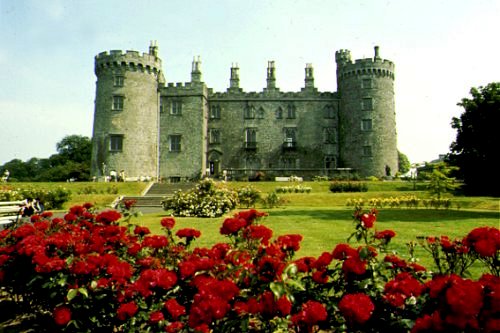 Kilkenny Castle
- is a castle
in Kilkenny,
Ireland
built in 1195 by William
Marshal, 1st Earl of Pembroke to control a fording-point of the River
Nore and the junction of several routeways
Kilkenny Castle
- is a castle
in Kilkenny,
Ireland
built in 1195 by William
Marshal, 1st Earl of Pembroke to control a fording-point of the River
Nore and the junction of several routeways
1317 Dame Alice Kyteler was charged with Heretical sorcery. She
had been married four times
1. William Outlawe of Kilkenny, a banker
2. Adam le Blund of Callan
3. Richard de Valle
4. Sir John le Poer
Three of which is stated that she had poisoned and the fourth deprived. Alice Kyteler escaped to England but not before she had named her accomplices. Of all the people that she had named, Petronilla, her maid, was condemned to death after torture til confession. She was burned alive November 3 1324 under Bishop Richard de Ledrede. The others were either burned, whipped, banished, or excommunicated.
Kilkenny,
Ireland's Medieval City -
"Proceedings against Dame Alice Kyteler", Camden Society,
(London, 1843)
Lea, Henry Charles, "History of the Inquisition of the Middle
Ages" (New York, 1887,1955,; London, 1888) "Transactions of the
Ossory Archaeology Society", Vol. I (1889)
Witchcraft
in Medieval Kilkenny - Kilkenny's medieval witch- Dame Alice Kyteler
Dame Alice Kyteler was born at Kyteler's House, Kilkenny, where her
father carried on a banking business, in the year 1280. Her family came
to Ireland after the Norman conquest of 1169. When her father died in
1298, Alice, who was an only child, inherited his business and properties.
After his death she married one of his former associates, William
Outlawe, who was also a highly successful banker [ like
so many of the Templars ] from Coal Market Street
and like her father, of Norman stock. This man was the brother of Roger
Outlawe, Chancellor of all Ireland, whose position and power could one
day play a dramatic part in the saga of witchcraft and heresy for which
she would be charged, found guilty and sentenced to death. ... Dame Alice
and her disciples were condemned to be whipped through the streets, tied
at the back of a horse and cart after which Alice, as chief priestess and
instigator would be burned to the stake.
But by the political power of the Chancellor of all Ireland, her former
brother-in-law Sir Roger Outlawe, her escape was organised. Her guards
were beaten senseless and Dame Alice was released from the dungeons
beneath Kilkenny Castle and freed from the sentence of death that hung
over her.
William Oultawe, Alyce Kyteler’s son by her first husband, was imprisoned for nine weeks and fined. He was then allowed to recant and receive Church sacraments, on condition that he make a pilgrimage to the Shrine of St. Thomas at Canterbury, and pay for the re-roofing in lead of St. Canice’s--today called St. Mary’s--Cathedral in Kilkenny Town. (Modern Kilkenny residents still wink at the witchly irony that this penance caused the too-heavy roof to cave in, as described in Chapter XVII.)
Secondhand
Historical Books of Irish Interest (Part 1 of 2)
MCNEILL, CHARLES: Register Of Chapter Acts Of The Hospital Of Saint John Of Jerusalem In Ireland 1326 - 1339 Under The Grand Prior, Sir Roger Outlawe. The Stationary Office, 172pp. Cloth. £30.00
From 1311 to 1340 the office was held by the Irish knight Sir Roger Outlawe, who was also Lord Justice of the kingdom. [He died in office1340] ... The Priory of Kilmainham
History and antiquities of Kilkenny (County and City): Volume 1 By William Healy
The Royal Hospital for disabled or superannuated soldiers, founded by Charles II, in 1679, now occupies the site of the ancient Priory of Kilmainham. Its chapel has a stained glass window, which is said to have originally belonged to the Hospitallers' Chapel.
This is the sole traditional remnant of the Knight Hospitallers of Kilmainham, the proudest and most chivalrous order of Knights that ever figured in the drama of human existence, or brightened the pages of history with deeds of glory.
Lord of Slanes
1174 - Priory of KILMAINHAM was erected on the site
of KILMAIGNEND by RICHARD (de Clare) STRONGBROW, EARL OF PEMBROKE for the. KNIGHTS
TEMPLARS dedicated to ST. JOHN
John Fitz Nicholas of Slanes is the first recorded holder of the Manor. Fitz Nicholas of Slanes entered into rebellion with Edward Bruce (1318) which ended in failure at the Battle of Faughart. For his bad judgment Fitz Nicholas was forced to forfeit his lands. Three (3) years later, Edward II granted the Lordship to the Priory of St. John of Jerusalem.
Full text of The lives of the Lord Chancellors and Keepers of the Great Seal of
Ireland, from the earliest times to the reign of Queen Victoria
...
This remarkable case demands notice. Dame Alice Case of Kyteler had been
four times married to men of wealth. Her first husband was named Utlagh,
and she bore him a son, William Utlagh, who followed the employment of
a merchant, and had money dealings with several of the chief nobles of the
colony. The Sheriff of Kilkenny, by direction of the Seneschal of that
liberty, Fulke de la Freegne, broke into Utlagh's house at night with an
armed force, dug up and carried off with other moneys the sum of three
thousand pounds, which was privately concealed by Utlagh and held
in trust for his relative Adam le Blund, of Callan.
Alice, his mother, appears to have been in partnership with her son, and not over nice in her modes of accumulating wealth. She is reported to have sought to increase her store by the refuse and sweeping of the * Fair Citie on the Nore ' where there is Air without fog, Fire without smoke, Water without mud, And the streets paved with marble. She also reaped a harvest by dealing in witchcraft, for the Alice dealt in witchcraft.
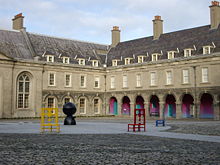 The Manor of Kilmainham was one of several manors, or liberties, that
existed in Dublin,
Ireland since
the arrival of the Anglo-Normans
in the 12th century. The manors were town lands united to the city, but still
preserving their own jurisdiction
The Manor of Kilmainham was one of several manors, or liberties, that
existed in Dublin,
Ireland since
the arrival of the Anglo-Normans
in the 12th century. The manors were town lands united to the city, but still
preserving their own jurisdiction
The boundaries of this liberty were first drawn up by John, when lord of Ireland, in 1192, referring to a former charter of local franchises granted by king Henry II (now lost). The lands on the banks of the Liffey at Kilmainham, near Dublin, first belonged to the Knights Templars and with their dissolution were given to the priory of the Knights of St. John of Jerusalem, who remained in possession until the dissolution of the monasteries in the 16th century.[2]
The Royal Hospital Kilmainham - in Kilmainham, Dublin is one of the finest 17th-century buildings in Ireland.
The hospital was built in 1684 by Sir William Robinson, official State Surveyor General for James Butler, 1st Duke of Ormonde and Lord Lieutenant of Ireland to King Charles II, as a home for retired soldiers and continued in that use for over 250 years. The style is based on Les Invalides in Paris with a formal facade and a large courtyard. The Royal Hospital Chelsea in Chelsea, London was completed two years later and also has similarities in style.
Royal Hospital:
The Royal Hospital Kilmainham
is a mile and a half west of the city centre and at the time of its construction
the site was contiguous with the Phoenix Park. The hospital was built in 1684 by
Sir William Robinson, official State Surveyor General for James Butler, 1st Duke
of Ormonde and Lord Lieutenant of Ireland to King Charles II, as a home for
retired soldiers and continued in that use for over 250 years.
Based on Les Invalides in Paris, the building consists of four unbroken ranges
enclosing a courtyard. It is similar to Les Invalides in its purpose, the
adoption of a closed courtyard plan with arcaded walks corresponding to passages
on the floors above. Two years after the building was started Wren began to
build a similar Hospital at Chelsea.
Of course the site of The Royal Hospital at Kilmainham had a previous
significant history. It was the site of St. Mhaighneann’s Church in the
7th century. Brian Boru assembled his army at Kilmainham prior to the Battle
of Clontarf.
Later this was the same site where the Strongbow built a monastery for
Knights Templars in 1174 after the Norman invasion.
The monastery/hospital was used as a seat of power for the English Government
in Ireland for 300 hundred years.
The Priors of Kilmainham often held the highest civil offices in the “Kingdom.” Parliaments were often held in the “Castle” of Kilmainham.
In 1309 The Knights Templar were suppressed by the Pope, The King of France
and the King of England. All of their very valuable properties throughout
Ireland were given to The Knights Hospitallers.
The Knights Hospitaller then transferred their head-quarters from Wexford to
Kilmainham. The Priors of Kilmainham continued to command significant civil
power and were relied upon by the Kings and Queens of England to maintain their
control in Ireland up until the reign of Henry VIII.
The most famous Prior of Kilmainham was Roger Outlaw. He became prior of
Kilmainham in 1316.
In 1317 Outlaw was granted the fee-farm of Chapelizod. Which was then added
to the lands of the monastery. Also in 1317 Outlaw convened a Parliament at
Kilmainham at which he secured the release of Richard De Burgo, Earl of Ulster
who had been imprisoned by the Mayor and Commons of Dublin on suspicion of
aiding the Scottish invasion of Ireland by Robert de Bruce.
In 1318 Outlaw was made Lord Treasurer of Ireland where upon he bound
himself and his successors to pay £300 a year to the Archbishop of Dublin to
exercise Episcopal jurisdiction in Rathmore and neighbouring churches.
Also in 1318 King Edward recognising the success of Outlaw’s organisational
skills and the charitable work of the monastery granted that all deoudands
accruing to Ireland for the ensuing year should be paid towards the support of
the poor flocking to Kilmainham.
In 1326 Outlaw granted Nickolas de Rosse a pension of twenty shillings of silver
for defending the monastery in courts. Also in the same year he gave
accommodation to William De Wideworth in Dublin near Bothe street (later
Fishamble Street). Outlaw played an important part in securing peace between
many various factions in Ireland. A vicious civil war broke out among the Norman
barons with the Fitzgeralds, the Butlers and the Berminghams on one side and the
De Burgs and the Le Poers on the other.
The native Irish took the opportunity to engage in attacks on both sides as
their common enemies. Their activity compelled the barons to feel that they were
engaged in a work of self-extermination.
Roger Outlaw addressed himself with creditable zeal to establish peace among
them and the native chieftains having gained no advantages of a permanent
character from their constant struggles offered to submit themselves to the
government and Outlaw thus prevailed.
Outlaw petitioned the King to have the whole body of English law applied to
Ireland. An offer of eight thousand marks was offered but the English
administration rejected the offer in the belief that the condition in Ireland
was in too great a state of ferment and commotion. The Irish chieftains were
most anxious to secure the protection of the common law but the English invaders
wanted the freedom to annex the property of the native Irish.
Outlaw had to contend with newly created Earls of Desmond, Ormonde, Ulster,
Meath, Kildare, Leix, Kilkenny, Wexford and Carlow as well as the native Irish
chieftains the O’Neills, the McCartans, O’Moores, O’Dempseys, O’Connors,
O’Tooles, the McMurroughs and the O’Riellys. Outlaw travelled to London on
two occasions in 1323 and again in 1331 to report to the King on the state of
things in Ireland. In 1331 he assisted the king’s finances with a loan of £200.
In 1331 the King again affirmed the possessions of Kilmainham under Roger
Outlaw. The King also bestowed the church of Ballyogarry on Kilmainham. In
1333 Outlaw bestowed a pension of £40 on William Kardleby in recognition of
goods and services provided to Kilmainham. In 1334 Outlaw granted John Joyce
Chaplin, the church of St. Michael in Wexford with all the profits therefrom for
life at an annual rent of four marks of silver, all taxes and burdens to be duly
paid.
In 1335 Outlaw gave a pension of 13 shillings and 4 pence to Adam de Kingston
and he granted the church of Ballyogarry to Bartleby Clake in lieu of a pension
of £40. He also granted to Hammond de Lee the post of park-keeper of Kilmainham
with a daily allowance of a white loaf, a household loaf, a flagon of best ale,
a dish of meat from the kitchen and a half a mark of silver annually for the
purchase of shoes. Outlaw gave numerous similar pensions to various persons
connected with the monastery and to persons outside of it.
In 1338 the King rewarded Roger Outlaw for his long service and loans of
money with custody of the manor at the Salmon Leap in Leixlip.
In 1341 Roger Outlaw, still Prior, Chancellor and Lord Justice of Ireland
died at Aney (Knockainy Co. Limerick) “ a prudent and upright man who by
his care and the special favour and licence of the king, had procured many
lands, churches and rents for order of the Knights Hospitallers.”
The next most important Prior of Kilmainham was John Rawson. Rawson was born in
Yorkshire in England in 1470. He joined the Order of St. John of Jerusalem in
1497. He was appointed prior of Kilmainham 1511. In 1517 he was elevated to the
position of Treasurer of Ireland.
Rawson’s tenure at Kilmainham coincided with the reign of Henry VIII. In
September 1529 Prior Rawson became part of Henry VIII's special and secret
Council of Three Ministers. In addition to the Prior of Kilmainham, the Council
included the Chancellor and Archbishop of Dublin, John Alen and the Chief
Justice, Patrick Bermingham.
The final phase in the history of the Irish Hospitallers at Kilmainham took
place amid the political upheaval of the Kildare rebellion and the subsequent
programme of political and ecclesiastical reform introduced by Henry VIII's
chief minister Thomas Cromwell.
Throughout this period the fate of Kilmainham and the Irish priory was placed in
the hands of John Rawson. Rawson was one of the few ministers to remain loyal to
the crown during the Kildare rebellion. In fact, the castle at Kilmainham came
under attack from the forces of Silken Thomas in 1532.
From the crown inquisitions taken at Kilmainham's dissolution, reference is made
to "a barn with stone walls the roof of which Thomas Fitzgerald, rebel and
traitor, about six years ago burned and destroyed with all the grain
there". Events in Ireland were affected by the political crisis in England
arising from Henry VIII's divorce In 1536, a Bill for the "suppression of
certain monasteries" was put before parliament.
This was the beginning of a campaign of dissolution that would not end until
1540. The final casualty would be Kilmainham. The early targets of the royal
commissioners were the smaller monasteries in outlying areas. However, Sir
William Brabazon, the undertreasurer, as early as autumn 1536, recognised the
potential value of the wealthier Dublin monasteries, including Kilmainham.
Brabazon's reason for not pressing for its immediate suppression was that he
thought it would be better to wait until the death of the ageing Prior Rawson.
Brabazon again suggested in 1537 that the closure of the bigger monasteries with
a yearly revenue of 2,000 marks would go towards the support of the army.
Included in the proposal was the suggestion that the Knights Hospitallers' land
should be confiscated. John Alen suggested that Rawson should retire to an
estate he held in England.
However Rawson was reluctant to do so. Kilmainham was the last monastery to be
surrendered. It was surrendered on the 12th November 1540 "by Sir John
Rawson, Knight, the Prior, with the consent of his confreres". He was
awarded a crown pension of 500 marks.
The Brabazons gained some of the lands associated with the Hospital and continue
to benefit from those grants even to the present day. The construction of the
modern hospital was recognised even in its day as significant bulwark for the
English administration in Ireland.
Many of the viceroys and commanders-in-chief operated from the Royal Hospital
Kilmainham. General Lake who defeated the Rebellion of 1798 was head-quartered
at the Royal Hospital Kilmainham. Robert Emmet who led the Rebellion of 1803 was
particularly concerned to cut-off access to the city by troops stationed at the
Royal Hospital.
....
The interiors of the building are largely destroyed by the building's conversion
into an art gallery but the interiors of the chapel and main hall are still
intact.
For a time the quadrangle was used for storage of old statuary of British
monarchs that were removed from public spaces in Dublin after independence.
A statue of Queen Victoria that came from the front of Leinster House, was
stored here for many years before being sold to the city of Victoria in
Australia.
To the north of the building lie the recently restored formal gardens. The Tudor
Gothic gateway at the end of the formal avenue leading to the Royal Hospital was
designed by Francis Johnston, one of the leading architects of the day.
This gateway originally stood beside the river Liffey at Bloody Bridge (now Rory
O'More Bridge), but had to be moved after the arrival of the railway in 1844
increased traffic congestion (obviously not new to Dublin).
He had placed his personal coat of arms above the arch, concealed by a piece of
wood painted to match the stone, his idea being that his arms would be revealed
to future generations after the wood became rotten.
However, his little trick was uncovered when the gateway was taken down for
removal. The coat of arms at present on the gateway is that of the Royal
Hospital.
Following the creation of the Irish Free State the Royal Hospital was considered
as a potential home for Oireachtas Eireann, the Irish national parliament.
Eventually it was decided to keep parliament in its temporary home in Leinster
House.
The Hospital remained the home of a dwindling number of soldiers, before being
variously used by the Garda Siochana (the Irish police force) and as a storage
location for property belonging to the National Museum of Ireland.
The Royal Hospital in Kilmainham was finally restored by the Irish Government
in 1984 (its 300th anniversary) and controversially opened as the Irish Museum
of Modern Art (IMMA).
Some people working in heritage organisations criticised the decision to
demolish the eighteenth century barrack rooms in one section of the quadrangle
to create open spaces for the IMMA.
A new foyer and bookshop area was constructed within the external fabric of the
old building and this contains a magnificent glass and steel staircase.
Every year on the National Day of Commemoration - the Sunday nearest July 11th -
the anniversary of the Truce that ended the Anglo-Irish War - the President of
Ireland, in the presence of members of the Government of Ireland, members of Dáil
Éireann and of Seanad Éireann, the Council of State, the Defence Forces, the
Judiciary and the Diplomatic Corps, lays a wreath in the courtyard in memory of
all Irishmen and Irishwomen who have died in past wars and on service with the
United Nations.
Leixlip (County Kildare Ireland)
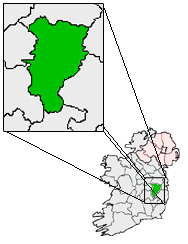
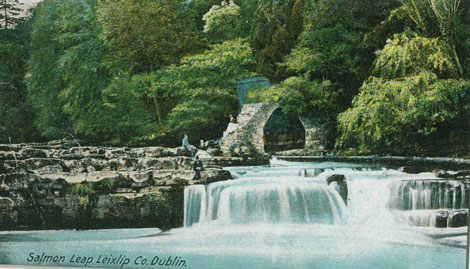 Kildare History and Family Research Centre
Kildare History and Family Research Centre
Chancery Miscellanea Bundle 87. File 2 (14) 40 Edw. III, is " Extracts from the memoranda of the Irish Exchequer, 40 Edw. III, as to the Manor of Salmon Leap granted to the prior of St. John of Jerusalem in Ireland"
Chancery Miscellanea Bundle 10, No.20 (1) 15 Edw. III, refers to the extent of the manor of Leixlip granted to Roger Outlawe, prior of the Hospitallers.
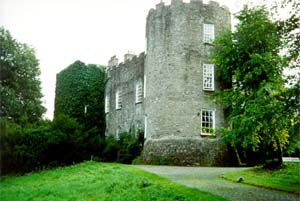 Leixlip Castle. Built on a rock at the confluence of the River Liffey
and the Rye Water, the central part of the castle dates from shortly after the Norman
Invasion of 1171
and is one of the oldest continuously-inhabited buildings in Ireland, pre-dating
Dublin
Castle by 30 years. It was used as a hunting base by King
John when Lord
of Ireland in 1185. It was not of major military importance but withstood a
4-day siege by the army of Edward
Bruce in 1316.
Leixlip Castle. Built on a rock at the confluence of the River Liffey
and the Rye Water, the central part of the castle dates from shortly after the Norman
Invasion of 1171
and is one of the oldest continuously-inhabited buildings in Ireland, pre-dating
Dublin
Castle by 30 years. It was used as a hunting base by King
John when Lord
of Ireland in 1185. It was not of major military importance but withstood a
4-day siege by the army of Edward
Bruce in 1316.
The property of the Whyte family from the 1500s to 1734, it was then bought by the Conolly family of nearby Castletown House, who sold it in 1914.
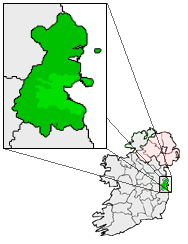 Clontarf, Dublin
(Irish:
Cluain Tarbh, meaning "Bulls'
Meadow") is a coastal suburb on the northside
of Dublin, Ireland.
It is most famous for giving the name to the Battle
of Clontarf in 1014 during which Brian
Boru, High King of Ireland defeated the Viking
invaders. This battle, which extended to districts over several miles, is seen
as marking an end to the Irish-Viking Wars.
Clontarf, Dublin
(Irish:
Cluain Tarbh, meaning "Bulls'
Meadow") is a coastal suburb on the northside
of Dublin, Ireland.
It is most famous for giving the name to the Battle
of Clontarf in 1014 during which Brian
Boru, High King of Ireland defeated the Viking
invaders. This battle, which extended to districts over several miles, is seen
as marking an end to the Irish-Viking Wars.
Clontarf lacks a single "village centre" but has a range of commercial facilities in several locations, mainly centred around Vernon Avenue. Clontarf adjoins Fairview, Marino, Killester, Artane and Raheny, and is in the postal district Dublin 3.
The manor and church of Clontarf were held by the Templars and subsequently the Hospitallers, and there was a Holy Well in the area, near what is now The Stiles Road, until recent times (another spring, named for Brian Boroimhe, of uncertain age, still exists, on Castle Avenue near the sea).
A manor house and small associated village was located on the slight ridge overlooking the sea where the Clontarf Castle Hotel is now situated. The manor house was rebuilt many times, with the current hotel dating largely to the early 19th century. The tower house on the site is a 19th-century replica of the original Templar structure on the site. The adjoining ruined church is the old Church of Ireland parish church, dates to the mid-17th century and includes what may be the earliest use of red brick in Ireland.
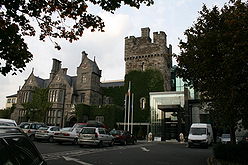 The
deLacy family and the Templars
The
deLacy family and the TemplarsThe first castle on the grounds, of which no trace remains, was built in 1172 by either Hugh de Lacy, lord of Meath, or his tenant Adam de Phepoe. Clontarf was subsequently held by the Knights Templar and, after their suppression in 1308, passed to the Knights Hospitaller, until they were in turn deprived of it at the Dissolution of the Monasteries. The last prior, Sir John Rawson, was created Viscount Clontarf in 1541 in return for surrendering the castle and its lands to the crown.
Clontarf Online - Clontarf A History - clontarfonline.com
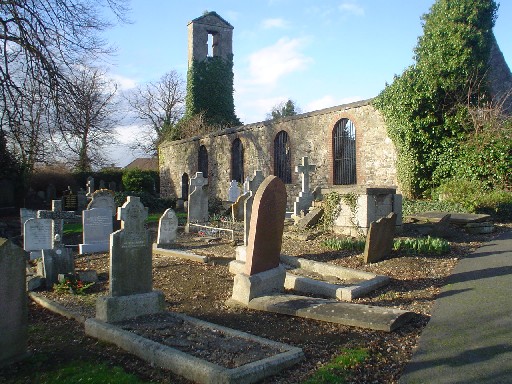 Two hundred years ago,
Clontarf was a rather isolated coastal village and access to it from the
city, other than by sea, would have been along what is now Summerhill and the Malahide Road with a south turn at Artane through the present Killester and Castle Avenues. It was part of the district of Cianachta and later of Fingal. Arelic of the old Cianachta remains in the name of the River Naniken (Abha na gCian), which flows through St.Anne's Park.
Two hundred years ago,
Clontarf was a rather isolated coastal village and access to it from the
city, other than by sea, would have been along what is now Summerhill and the Malahide Road with a south turn at Artane through the present Killester and Castle Avenues. It was part of the district of Cianachta and later of Fingal. Arelic of the old Cianachta remains in the name of the River Naniken (Abha na gCian), which flows through St.Anne's Park.
The First church in Clontarf was founded by the great abbot of Bangor, St. Comgall, around 550, and it would have been a part of the evangelical efforts from the monastery and school of St.Mobhi at Glasnevin to the area from Fingal to Swords and Sutton.
St. Comgall was the patron of Clontarf until, with the advent of the Knights of St. John of Jerusalem, he was supplanted by St. John the Baptist.
...
The progress towards the establishment of a stable order of government in Ireland after Clontarf was finally frustrated by the arrival of new invaders. The Normans, greedy for the land and power, immediately set about enforcing their foothold and one of them
Adam de Pheope, erected the
Castle of Clontarf . He had however to yield to royal pressure, and here Henry II, as part of his penance for the murder of St.Thomas a Beckett, established a priory of the Knights
Templar. On their suppression in 1307, the property passed to the Knights of St. John of Jerusalem, whose headquarters in Ireland was in Kilmainham
. ...
On 22nd November 1540 the priory of Kilmainham was surprised and its property surrendered to the king. This would have included the estate at Clontarf, but it would seem that the last prior, John Rawson, had anticipated the move because, in 1538, he had leased Clontarf Castle, and here he died in 1547
Topic Eleven major preceptories and manors of the Templar Order have been identified, namely, Clontarf in County Dublin (which was the most important preceptory in Ireland), Rathronan and Athkiltan in County Carlow, Gowran in County Kilkenny, Crook and Kilbarry in County Waterford, Templehouse in County Sligo where the Knights Templar built their most westerly European stronghold in 1216, Kilsaran and Cooley in County Louth (the most wealthy apparently), Clonaul in County Tipperary and Kilclogan (Templetown) in County Wexford.
Clontarf Castle was burned in 1641 by Cromwell's General, Sir Charles Coote, apparently in revenge for the disloyalty of the then owner, George King
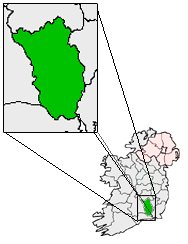 Kilkenny
(from the Irish:
Cill Chainnigh meaning "Cell or church of Cainnech/Canice")[1]
is described as a city[2]
and is the traditional county
town of County
Kilkenny in Ireland.
It is situated on both banks of the meandering River
Nore, at the centre of County
Kilkenny in the province
of Leinster
in the south-east of Ireland.
Kilkenny is described as Kilkenny City or the City of Kilkenny but
is administered as a borough, with a twelve-person Borough
Council and a Lord
Mayor. The borough has a population of 8,661, however the majority of the
population live outside the borough boundary, the 2006 Irish Census gives the
total population of the Borough & Environs as 22,179.
Kilkenny
(from the Irish:
Cill Chainnigh meaning "Cell or church of Cainnech/Canice")[1]
is described as a city[2]
and is the traditional county
town of County
Kilkenny in Ireland.
It is situated on both banks of the meandering River
Nore, at the centre of County
Kilkenny in the province
of Leinster
in the south-east of Ireland.
Kilkenny is described as Kilkenny City or the City of Kilkenny but
is administered as a borough, with a twelve-person Borough
Council and a Lord
Mayor. The borough has a population of 8,661, however the majority of the
population live outside the borough boundary, the 2006 Irish Census gives the
total population of the Borough & Environs as 22,179.
Kilkenny is a popular tourist destination in Ireland. In 2009 the City of Kilkenny celebrated its 400th year since the granting of city status in 1609.[3] Kilkenny's heritage is evident in the city and environs including the historic buildings such as Kilkenny Castle, St. Canice's Cathedral and round tower, Rothe House, Shee Alms House, Black Abbey, St. Mary's Cathedral, Kilkenny Town Hall, St. Francis Abbey, Grace's Castle, and St. John's Priory. Kilkenny is regarded for its culture with craft and design workshops, the Watergate Theatre, public gardens and museums. Annual events include Kilkenny Arts Week, the Cat Laughs comedy festival and music at the Rhythm and Roots festival and the Source concert. It is a popular base to explore the surrounding towns, villages and countryside.
Kilkenny began with an early sixth century ecclesiastical foundation. Following Norman invasion of Ireland, Kilkenny Castle and a series of walls were built to protect the burghers. William Marshall, Lord of Leinster, gave Kilkenny a charter as a town in 1207. By the late thirteenth century Kilkenny was under Norman-Irish control. The Statutes of Kilkenny passed at Kilkenny in 1367, aimed to curb the decline of the Hiberno-Norman Lordship of Ireland. In 1609 King James I of England granted Kilkenny a Royal Charter giving it the status of a city. Following the Rebellion of 1641, the Irish Catholic Confederation, also known as the "Confederation of Kilkenny", and was based in Kilkenny and lasted until the Cromwellian conquest of Ireland in 1649. Kilkenny was a Norman merchant town in the Middle Ages. Kilkenny was a famous brewing centre from the late seventeenth century. In the late twentieth century Kilkenny is a tourist and creative centre.
The Heritage Council offices are located at Church Lane. The seat of the Roman Catholic Bishop of Ossory is at St. Mary's Cathedral and the Church of Ireland Bishop of Cashel and Ossory is at St. Canice's Cathedral. Nearby larger cities include Waterford 45 km (28 miles) south-southeast, Limerick 93 km (58 miles) west and Dublin 101 km (63 miles) northeast.[4]
Families of County
Limerick: This is the 5th book in our 32 volume 'Irish Families' series. It focuses only on families found in County Limerick and includes families of all religions and backgrounds, including old Irish families and settler families. It follows the master volume to the set, "The Book of Irish Families, great & small" which contains information on families from all of Ireland.
Outlaw, Outlawe
28474-8 Notes and Queries, Number 192, July 2, 1853
The next extract bears upon the communication at Vol. vii., p. 332.:
"An _Ultagh_ hath three purses. He runneth behind dore to draw his money: one cutteth the throte of another."
Now, was an _Ultagh_ an Irish usurer or money-lender? Your correspondent at
page 332. requests information respecting Roger Outlaw. Sir William Betham, in a
note to the "Proceedings against Dame Alice Ugteler," the famous
pseudo-Kilkenny witch, remarks that "the family of Utlagh were seated in
Dublin, and filled several situations in the corporation." Utlagh and
Outlaw are the same surnames.
The named Utlagh also occurs in the Calendar of
Printed Irish Patent Rolls. William Utlagh, or Outlaw, was a _banker_ and
_money-lender_ in Kilkenny, in the days of Edward I. He was the first husband of
the witch, and brother of Friar Roger Outlaw. In favour of the latter, who was
Prior of Kilmainham, near Dublin, a mandamus, dated 10 Edw. II., was issued for
arrears due to him since he was "justice and chancellor, and even
lieutenant of the justiciary, as well in the late king's time as of the present
king's." He was appointed Lord Justice, or deputy to the Lord Lieutenant,
by patent dated Mar. 15, 9 Edw. III.
Many of the Irish records having been lost,
your correspondent will do an obliging service in pointing out the repository of
the discovered roll. Perhaps steps might be taken for its restoration. H. [The
following communication from our valued correspondent, the REV. H. T. ELLACOMBE,
affords at once a satisfactory reply to H's Query, and a proof of the utility of
"N. & Q."] _Roger Outlawe_ (Vol. vii., p. 559.).--Thanks to ANON.
and others for their information.
Lord Mayor of Kilkenny - Wikipedia, the free encyclopedia
The Lord Mayor of Kilkenny is the Mayor of Kilkenny City. Kilkenny's first Council was elected in 1231 and since then Kilkenny has had a continuous record of municipal government. From the 13th century to the end of the 16th the chief magistrate was known as the Sovereign, and since then Mayor.
Unfortunately, there is no record of who that first sovereign was.
The
earliest name mentioned in Liber Primus appears to be that of Henricius
Owtlawe who is mentioned in a copy of a grant dated 1312.
1280 - Jose de Keteller father of Alice Kyteller died
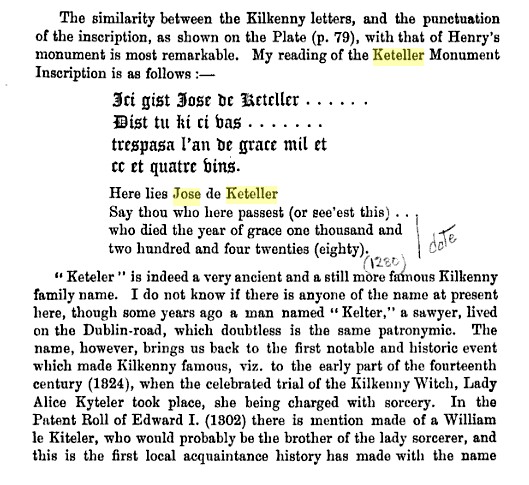
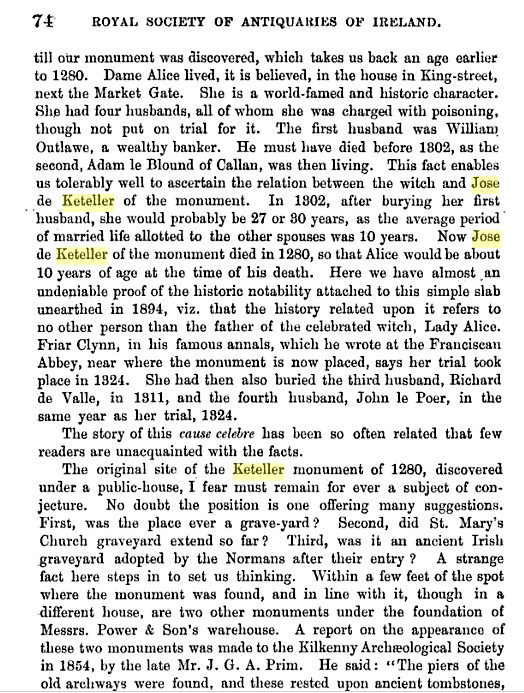
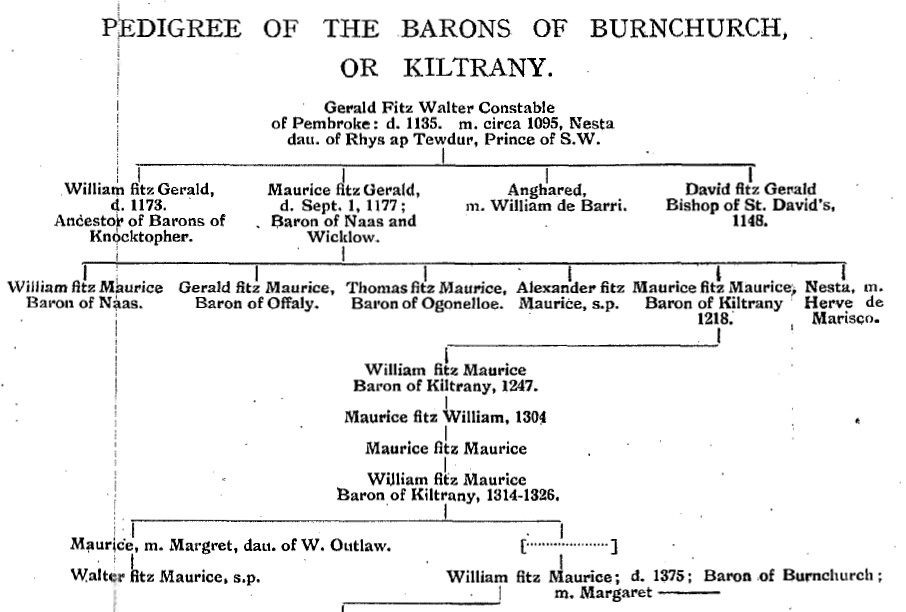
Interesting in the following, they show William fitz Maurice as the son of Maurice as a second son) : Also notice they take the Fitzgerald moniker.
ThePeerage.com - Person Page 26681
Margaret (?) married William
fitz Maurice Fitzgerald, 1st
Baron of Burnchurch, son of Maurice
fitz William Fitzgerald and Margaret
Outlawe.1
Her married name became Fitzgerald.1
Early FitzGerald (Baron, FitzMaurice) Family History in Kilkenny
Roland above was but a mere child, at the death of his father, William
Fitz Maurice, some time before March 28th, 1374. He was still a minor, March
8th, 1390. He was appointed Keeper of the Peace for Co. Kilkenny, in 1405, and
again in 1410. In the later year, he, and his wife, Margaret, had a grant of 1
messuage and 1 1/2 carucates of land in Kenokestoun. Published records mention
him for the last time, in 1414, when the King granted him, for his services, a
life pension of £12 a year.
His son and heir was Richard Fitz Maurice ("Rold' fil' Wmi genuit
Richm ", as shown in the Abstract), who, with his wife Johanna
Whytte, is mentioned on the oldest of the family tombs in Burnchurch.
Another Richard Fitz Maurice, or Baron, of Burnchurch (probably grandson of
Richard, son of Richard), and Patrick St. Leger, chief of his nation, appear in
1502, as witnesses to the identification of the will of Sir James Butler Mac
Richard, made in 1487.
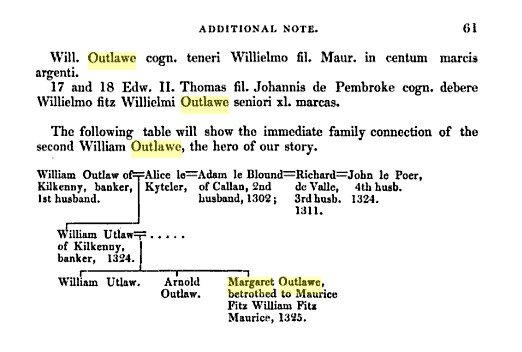 So
here we have William Outlawe Jr. with two sons William and Arnold and daughter Margaret.
So
here we have William Outlawe Jr. with two sons William and Arnold and daughter Margaret.
This conflicts with other information that William Jr. had a son Roger and that Margaret was daughter of William Sr.
William Outlawe Jr, may have named a son Arnold after the man who helped him Arnold de Poer, Lord of Kells [Paor]
"Outlaw was supported by Arnold de Poer, Lord of Kells who arrested the Bishop and had him imprisoned in Kilkenny Castle for 17 days."
http://snap.waterfordcoco.ie/collections/ejournals/103799/103799.pdf
...Maurice who married Margaret daughter of William Outlawe', in 1326
" It is quite possible from this William' (who died in 1375) "being called
Fitz Maurice that he was a younger son of Maurice who married the daughter of
Outlawe, and grand-daughter of the [Alice Keteler Outlawe ] witch." ...
we may and must conclude that Margaret Outlawe was
a worthy and pious lady of that period, and as such a meet prop to the house and
family she entered and enriched with her fortune and the two sons whom she presented in due time to her husband.
That her
grandmother on her father's side...
Burnchurch
More on William Fitz Maurice FitzGerald.....
THE
GERALDINES OF COUNTY KILKENNY. Part I.—THE BARONS OF BURNCHURCH.
By
GEO. DAMES BURTCHAELL, M.A., LL.B., M.R.I.A., Fellow.
Maurice fitz Gerald, who led the second band of Anglo-Norman invaders to Ireland, and who died 1st September, 1177, is said by Lodge to have had four sons—Gerald, William, Alexander, and
Maurice.* The latest pedigrees, however, give him five, as Lodge omitted the name of Thomas, the founder of the Desmond line, third son of the first Maurice.3
The two younger sons, Alexander and Maurice, are said to have died without
issue. In fact, little or nothing appears to have been known about this Maurice fitz Maurice, the youngest son, beyond his name.
The evidence supplied by the Register of the Monastery of Kells, however, leads to the conclusion that
this Maurice did not die without issue, but was founder of the Burnchurch family. The rectory and glebe of Kiltrany, or Burnchurch, was held by the Monastery of Kells down to the time of its dissolution, and in the Register of its
charters was recorded that of Maurice son of Maurice, the Baron and Knight, granting the lands of Kiltrany and the church there to the monastery.4 The witnesses are Lord H(ugh de Rous), Bishop of Ossory (1202-1218); G(ilbert), Archdeacon (1200-1206); O(do), Dean of Ossory ;6 and Matthew fitz Griffin, which fixes the date of the grant in the second decade of the thirteenth century; and William, son and heir of Maurice, confirms the gift of his father. This is no doubt the same Maurice fitz Maurice whose name appears as a witness to the charter granted to the town of Kells by William fitz
Geoffrey.6 The dates are quite consistent with his being the youngest son of Maurice fitz Gerald, the patriarch of the family, who took part in the conquest of Ireland.
...
"William fitz Maurice, son and heir of Maurice fitz Maurice, succeeded his father; and in the extent of the services due to Richard, Earl of Gloucester and Hertford, in the county Kilkenny, taken in the year
1247, We find him holding half of one knight's fee in " Kiltrasthy. "2 His son and successor, Maurice, is possibly identical
with Maurice fitz William who held land in Ballyleni, of Miles fitz Miles, in the Barony of Overk.3 To Maurice, the next in the line of descent, we have no reference; and this brings us to his son William.
On the death of Gilbert, last Earl of Gloucester and Hertford, of the de Clare family, -who fell at the Battle of Bannockburn in
1313, leaving no issue, his three sisters, the Ladies Alienore, wife of Hugh de Spencer, junior ; Margaret, wife of Hugh de Audley; and Elizabeth, widow of John de Burgh, became co-parceners of his inheritance, including the Lordship of Kilkenny.
A partition was soon afterwards made between them; and in the extent made upon this occasion,4 the portion allotted to Sir Hugh de Spencer, junior, and Alienore, his wife, includes "half of one knight's fee in Kiltrany, which William fitz Maurice holds."
Shortly afterwards we find "William fitz Maurice entering into a matrimonial alliance with the famous William Outlawe, the wealthy banker of Kilkenny, son of Dame Alice Kyteler, the supposed witch. In 1326 a deed was enrolled in Chancery made between "William fitz Maurice and William Outlawe,
History and antiquities of Kilkenny - William Healy
The Fitzgeralds, of Burnchurch, are very fully treated of by G. D.
Burtchaell, B.L., in "The Journal of the R.S;.A. Ireland," part 4,
vol. 2, p. 358-76. Mr. BurtcLaeli shows that "Baron," by which
members of the family are frequently designated, was not their original
patronymic, but a "title '' such as Lords Palatine were accumstomed. to
create within their counties, and confer on those to whom they had given
sub-grants. He surmises that the Fitzgeralds of Burnchurch were not
sprung from Maurice, first Knight of Kerry, as was generally supposed, but
from Maurice Fitzgerald, who took part in the conquest of Ireland in 1169.
Mr. Burtchaell states his fifth, or youngest son, Maurice FitzMaurice, who was
supposed to have died without issue, must in reality be considered the founder
of the Burnchurch family, and. identical with Maurice Fitz-Maurice, who,
according to the Registry of the Monastery of Kells, made a grant thereto of the
church and glebe of Kiltrany, or Burnchurch, early in the l5th century, and
consequently long before the time of the first Knight of Kerry.
Maurice Fitz-Maurice, left a son and heir, William Fitz-Maurice, Baron of
Kiltrany, living in 1247. He was succeeded by his son Maurice, who left a
son. Maurice Fitz-Maurice, whose son and heir, William Fitz-Maurice, was Baron
of Kiltrany, 1314-1326. Very probably, as Mr. Burtchaell states, it was in
his time that Kiltrany was burned by Bruce in his expedition to the south in
1316, and from the circumstance was afterwards called " Burntchurch."
William left a son Maurice, who married Margaret, daughter of William Outlaw,
of Kilkenny, sen of Alice Kyteller, the famous witch, who with her son and other
accomplices were tried for various heresies and sorceries in Kilkenny in 1324-5.
The history of this curious witchcraft case is given at considerable length in
the first volume of the "Transactions of the Ossory Arch. Society," p.
213-39.
Maurice left a son, Walter Fitz-Maurice, who died without issue.
William Fitz-Maurice, who married Margaret [ Outlawe ] — , and
belonging to a junior branch, succeeded to the estates.
As his son, Rowland, was a minor, in custody of David Wane—49 Ed. HI.
(1376)—William, his father, may have been, as Mr. Burtchaell suggests, a
younger son of Maurice, who married Margaret Outlaw. Rowland left a son,
Richard, ... Baron of Burnchurch. He left a son ,,, During the feuds
between the .... Earl of Ormonde, Rowland was takan prisoner .... to
attend the King's Parliament in Dublin. He was confined in irons for a long
time, and deprived of his horse, money and apparel, without restitution...
William Fitz-Maurice -> Rowland fitz Maurice -> Richard fitz Maurice
Early
FitzGerald (Baron, FitzMaurice) Family History in Kilkenny
...
Roland above was but a mere child, at the death of his father, William Fitz
Maurice, some time before March 28th, 1374. He was still a minor, March 8th,
1390. He was appointed Keeper of the Peace for Co. Kilkenny, in 1405, and
again in 1410. In the later year, he, and his wife, Margaret, had a grant of
1 messuage and 1 1/2 carucates of land in Kenokestoun. Published records mention
him for the last time, in 1414, when the King granted him, for his services, a
life pension of £12 a year.
His son and heir was Richard Fitz Maurice ("Roland' fil' Wmi genuit
Richm ", as shown in the Abstract), who, with his wife Johanna Whytte, is
mentioned on the oldest of the family tombs in Burnchurch. Another
Richard Fitz Maurice, or Baron, of Burnchurch (probably grandson of Richard, son
of Richard), and Patrick St. Leger, chief of his nation, appear in 1502, as
witnesses to the identification of the will of Sir James Butler Mac Richard,
made in 1487.
Burnchurch Castle - is situated about 4 miles south west of Kilkenny and 6km from Ballybur, off the Clonmel Road.
Burnchurch
is a six storey tower house. The castle was originally attached to a walled
courtyard, most of which has now disappeared, apart from a 40 foot high tower at
one corner. The castle has an unusual complexity of passages and chambers
inside the walls, including a hidden room in the wall of the fourth floor..
There used to be great hall attached to an outside wall of the tower which has
now gone. There is a vault under the castle above which is the main chamber.
Access to the upper three floors is via an outside staircase. Other notable
features include mullioned windows, a fine carved fireplace and a round chimney
which may have been a later addition.
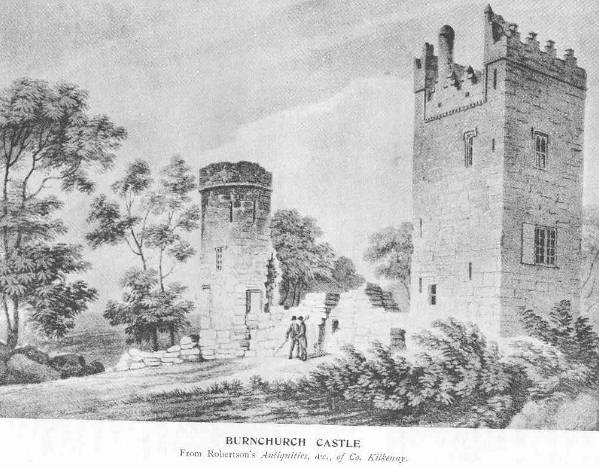
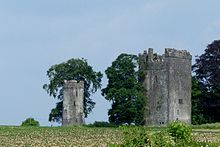
The Fitzgerald DNA Project Patriarchs
Walter Fitzother, Constable of Windsor and Keeper of its Forest. in the
Doomsday Book (1086) - David Barron [d.e.barron AT tinyworld.co.uk ]
Gerald Fitzwalter, Constable of Pembroke m Nesta dau of Rhys ap Tewdwr, King of
Deheubarth and Prince of S Wales
Maurice Fitzgerald, Lord of Maynooth, Baron of Naas and Wicklow. Ancestor of the
Earls of Kildare & Dukes of Leinster, Earls of Desmond
Maurice Fitzmaurice, 1st Baron of Kiltrany 1218
William Fitzmaurice, Baron of Kiltrany viv1247
Maurice Fitzwilliam d 1304 mc 1259
Maurice Fitzmaurice dc 1317
William Fiztmaurice, Baron of Kiltrany 1314-1346
John Fitzwilliam held Knights fees co Kilkenny 1346 or Maurice who held Killesk
co Kilkenny 1326
William Fitzmaurice, (1st Baron of Burnchurch) d1375.
Rowland Fitzmaurice, Baron of Burnchurch 1375-1448
Richard, Baron of Burnchurch
Omitted in Burkes family records
Richard, Baron of Burnchurch viv 1502
Rowland Fitzgerald (alias Barron), Baron of Burnchurch.
John Fitzgerald (alias Barron), Baron of Burnchurch
Richard Fitzgerald, b c1548 d1602
Rowland Fitzgerald, Burnchurch mc 1590
Edward Fitzgerald, Bro. Richard Fitzgerald Baron of Burnchurch
Captain James Barron alias The Fitzgerald of Fahagh co Waterford.
Pierce Barron of Garrahilersh co Waterford m 1697
John Barron of Ballydurne, Ballyneale & Killconavey co Waterford b 1718
d1800
William Barron of Carrickbarron co Waterford JP. B c 1760
John Netterville Barron b1804 d 1849 of Ballydavid co Waterford and Uregare Hse
co Limerick
Albert Henry Barron b 1843 d1929
Arthur Frederick Netterville Barron b 1882 d 1936 F-26
thePeerage.com - Margaret Outlawe
Sir Arnold le Poer - was kin to Dame Alice's fourth husband.
He protected William
Outlawe from the bishop De Ledrede and died for it...
A later seems to have been named in his honour ... Arnold Outlawe
"Outlaw was supported by Arnold de Poer, Lord of Kells who arrested the Bishop and had him imprisoned in Kilkenny Castle for 17 days."
The peerage of Ireland: a genealogical and historical account Volume 1 By Edward Kimber, John Almon
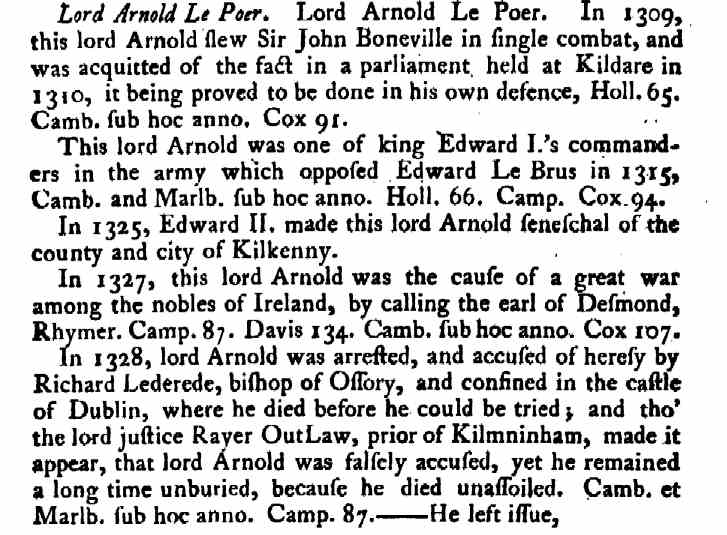 - Irish Witchcraft and Demonology Chapter II A.D.
- Irish Witchcraft and Demonology Chapter II A.D.
1324 Dame Alice Kyteler, The Sorceress of Kilkenny
On ascertaining the above the Bishop wrote to the Chancellor of Ireland, Roger Outlawe, who was also Prior of the Preceptory of Kilmainham, for the arrest of these persons. Upon this William Outlawe formed a strong party to oppose the Bishop's demands, amongst which were the Chancellor, his near relative, and Sir Arnold le Poer, the Seneschal of Kilkenny, who was probably akin to Dame Alice's fourth husband. The Chancellor in reply wrote to the Bishop stating that a warrant for arrest could not be obtained until a public process of excommunication had been in force for forty days, while Sir Arnold also wrote requesting him to withdraw the case, or else to ignore it. Finding such obstacles placed in his way the Bishop took the matter into his own hands, and cited the Dame, who was then in her son's house in Kilkenny, to appear before him.... Foiled in this, he cited her son William for heresy. Upon this Sir Arnold came with William to the Priory of Kells, where De Ledrede was holding a visitation, and besought him not to proceed further in the matter. Finding entreaty useless he had recourse to threats, which he speedily put into execution. As the Bishop was going forth on the following day to continue his visitation he was met on the confines of the town of Kells by Stephen le Poer, bailiff of the cantred of Overk, and a posse of armed men, by whom he was arrested under orders from Sir Arnold, and lodged the same day in Kilkenny jail.... After De Ledrede had been detained in prison for seventeen days, and Sir Arnold having thereby attained his end, viz. that the day on which William Outlawe was cited to appear should in the meantime pass by, he sent by the hands of his uncle the Bishop of Leighlin (Miler le Poer), and the sheriff of Kilkenny a mandate to the constable of the prison to liberate the Bishop... De Ledrede had been arrested by Le Poer's orders in Lent, in the year 1324...
| - - - - -
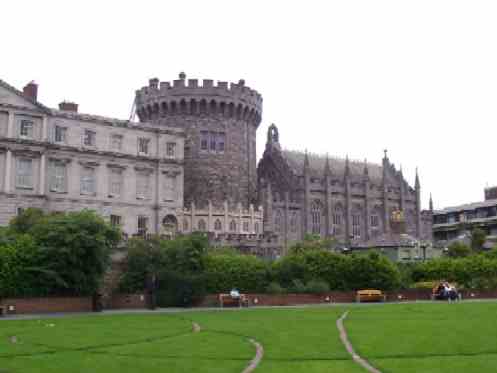 Sir Arnold
le Poer, who had taken such a prominent part in the affair, was next attacked.
The Bishop accused him of heresy, had him excommunicated, and committed prisoner
to Dublin Castle. His innocency was believed in by most people, and Roger
Outlawe, Prior of Kilmainham, who also figures in our story, and who was
appointed Justiciary of Ireland in 1328, showed him some kindness, and treated
him with humanity. This so enraged the Bishop that he actually accused
the Justiciary of heresy. A select committee of clerics vindicated the
orthodoxy of the latter, upon which he prepared a sumptuous banquet for his
defenders. Le Poer died in prison the same year, 1331, before the matter
was finally settled, and as he was under ban of excommunication his body lay
unburied for a long period. ...
Sir Arnold
le Poer, who had taken such a prominent part in the affair, was next attacked.
The Bishop accused him of heresy, had him excommunicated, and committed prisoner
to Dublin Castle. His innocency was believed in by most people, and Roger
Outlawe, Prior of Kilmainham, who also figures in our story, and who was
appointed Justiciary of Ireland in 1328, showed him some kindness, and treated
him with humanity. This so enraged the Bishop that he actually accused
the Justiciary of heresy. A select committee of clerics vindicated the
orthodoxy of the latter, upon which he prepared a sumptuous banquet for his
defenders. Le Poer died in prison the same year, 1331, before the matter
was finally settled, and as he was under ban of excommunication his body lay
unburied for a long period. ...
It is very probable, too, that there were many underlying local causes of
which we can know little or nothing; the discontent and anger of the
disinherited children at the loss of the wealth of which Dame Alice had bereft
them by her exercise of "undue influence" over her husbands, family
quarrels, private hatreds, and possibly national jealousy helped to bring
about one of the strangest series of events in the chequered history of Ireland
Dublin Castle - a castle has stood on the site since the days of King John, the first Lord of Ireland. The Castle served as the seat of English, then later British government of Ireland under the Lordship of Ireland (1171–1541)
THE NEW SETTLERS IN HY-KINSELAGH
The New Settlers who joined Strongbow in Ireland, and got large grants of
lands, were:
In Wexford--Maurice Fitzgerald, ancestor of the earls of Kildare and
Desmond;
Harvey de Monte Morisco,
and Robert Fitzstephen.
The other families who settled in Wexford were those of Carew, Talbot, Deveroux* Stafford, Sinnott, Sutton, Keating, Power, Walshe, Fitzharris, Fitzhenry, Derenzy, Masterson, Butler, Brown, Rositer, Redmond, Esmond, Hore, Harvey, Hay, Hughes, Codd, Comerford, Colclough, Lambert, Boyce, Morgan, Tottenham, Ram, Furlong, etc.
In the first volume of the Desiderata Curiosa Hibernica, an account is given of
various patentees and undertakers who, in the reigns of Elizabeth and King James the First, got extensive grants of forfeited lands which were confiscated in the county of Wexford.
The following persons obtained lots of those lands: Sir Richard Cooke, Sir Laurence Esmond, Sir Edward Fisher, Francis Blundell, Nicholas Kenny, William Parsons, Sir Roger Jones, Sir James Carroll, Sir Richard Wingfield, Marshal of the Army; Sir Adam Loftus, Sir Robert Jacob, Captain Trevellian, Captain Fortescue; and Conway Brady, Queen Elizabeth's footman.
Several families of the Old proprietors in Wexford are enumerated, with the lands they possessed, and the re-grants of part of those lands which they obtained; as those of Masterson, MacMurrough, MacBrien, MacDowling, MacDermott, Malone, Cavanagh, Moore, O'Bulger, O'Doran, Sinnot, Walsh, Codd, etc.
In Carlow the following have been the chief old English families:--De Bigod, earls of Norfolk, by intermarriage with the
daughter of William Marshall, Earl of Pembroke, became lords of Carlow in the thirteenth century;
and, A.D. 1346, the county of Carlow was granted to Thomas Plantagenet or De Brotherton, Earl of Norfolk and Marshal of England: whose successors, the Mowbrays, and Howards, dukes of Norfolk, possessed the county of Carlow down to the reign of King Henry the
Eighth, when they were deprived of it in consequence of the law against absentees being enforced; and after that time
the Butlers, earls of Ormond, became possessed of a great part of Carlow. It may be here observed, that in the fourteenth century the Courts of Exchequer and Common Pleas were for a long period held at Carlow.
The other chief families who settled in Carlow were the following: Butler, Brown, Burton, Bagnal, Carew, Cooke, Eustace, Rochfort, Cheever, Ponsonby, Astle or Astly, Bunbury, Blackney or Blackeney, Doyne, Bruen, etc.
In Wicklow, Maurice Fitzgerald and his descendants, in the reigns of Henry the Second and King John, got extensive grants of land about
Arklow; and Walter de Riddlesford, who had the title of "Baron of Brey," got from King John a grant of the lands of Imaile in Wicklow, and of Castledermot in Kildare; both of which belonged to the ancient principality of O'Toole. The other chief families of Wicklow were Butler, Talbot, Eustace, and Howard.
* Devereux: This is the gallicised form of the lrish sirname Leimhearois ("leimhe:" Irish, simplicity, folly, silliness; "aros," a dwelling, a house, or habitation. Compare with it the French Vereux, "worm-eaten" "rotten," etc.); of which family Tomhas Leimhearois (or Thomas Devereux) was an Irish Catholic Bishop, temp. Queen Elizabeth.
...
The family of the Fitzgeralds afterwards became earls of Kildare. Isabel,
another daughter of William Marshall, earl of Pembroke, had for her portion the
county Kilkenny, and was married to Gilbert de Clare, earl of Gloucester and
Hereford; and, leaving no issue, the county Kilkenny, after his decease, fell to
his three sisters, and passed by intermarriage chiefly to the family of De
Spencers, barons De Spencer, in England, and afterwards became possessed mostly
by the Butlers, earls of Ormond
The following have been the chief families since the English invasion in Kilkenny, King's, and Queen's Counties.
In Kilkenny: Butler, Grace, Walsh, Fitzgerald, Roth, Archer, Cantwell, Shortall, Purcell, Power, Morris, Dalton or D'Alton, Stapleton, Wandesford, Lawless, Langrish, Bryan, Ponsonby, etc. The Butlers became the chief possessors of the county Kilkenny, as earls of Ormond and Ossory, dukes of Ormond, earls of Kilkenny and Gowran, viscounts of Galmoy, and various other titles derived from their extensive estates in this county and in Tipperary. "The Graces:"
An account has already been given of Maurice Fitzgerald, a celebrated Anglo-Norman Chief who came over with Strongbow, and was ancestor of the earls of Kildare and Desmond. William Fitzgerald, brother of Maurice, was lord of Carew in Wales; and the descendants of one of his sons took the name of De Carew, and from them, it is said, are descended the Carews of Ireland, great families in Cork, Wexford, and Carlow.
From another of the sons of William Fitzgerald, were descended the Gerards, families of note in Ireland.
The eldest son of William Fitzgerald, called Raymond FitzWilliam, got the name of "Raymond le Gros," from his great size and strength; he was one of the most valiant of the Anglo-Norman commanders; was married to Basilia de Clare, sister of Strongbow; held the office of standard bearer of Leinster; and was for some time chief Governor of Ireland. Raymond died about A.D. 1184, and was buried in the Abbey of Molana, on the island of Darinis, on the river Blackwater, in the bay of Youghal.
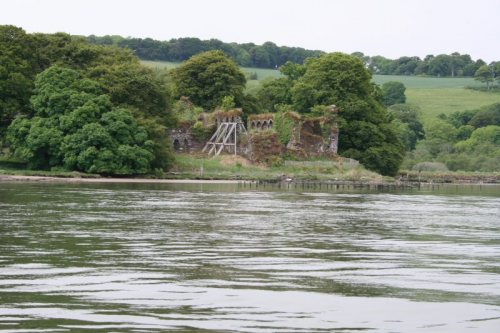 Molana
Abbey, originally built on an island, is accessible (on certain
days of the week) via an early C19th causeway built by Grice
Smyth. (Photo – Irish
Waterway History)
Molana
Abbey, originally built on an island, is accessible (on certain
days of the week) via an early C19th causeway built by Grice
Smyth. (Photo – Irish
Waterway History)
Founded in the C6th by Saint Maelanfaidh, the monastery was a powerful influence throughout Ireland for several centuries before falling victim to Viking rapacity.
It was re-established as an Augustinian Priory after the C12th arrival of the Normans by Strongbow’s colleague Raymond le Gros, who was reputedly buried here in 1186.
Maurice, the eldest son of Raymond le Gros, was ancestor of the great family of the FitzMaurices, earls of Kerry.
[ Which later a descendent marries Margaret Outlawe daughter of William Outlawe , see below]
Raymond had another son called Hamon le Gros, and his descendants took the name of "le Gros," or "le Gras," afterwards changed to Grace. The Graces were created barons of Courtown, and held an extensive territory in the county Kilkenny, called "Graces' Country;" but, in the wars of the Revolution, the Graces lost their hereditary estates: John Grace, the last baron of Courtown, having forfeited thirty thousand acres of land in Kilkenny for his adherence to King James the Second.
"The Walshes;" This family was, by the Irish, called Branaghs, from "Breatnach," which signifies a Briton: as they originally came from Wales with Strongbow and his followers. They therefore got extensive possessions in Waterford, Kilkenny, Wexford, and Carlow; and held the office of seneschals of Leinster, under the successors of Strongbow.
The Butlers, viscounts of Galmoy; the Graces, Walshes, Roths, and Shees, lost their extensive estates in Kilkenny, in the war of the Revolution. The Bourkes, a branch of the Bourkes of Connaught, settled in Kilkenny and Tipperary; and some of them in Kilkenny took the name of Gaul, from "Gall," the name by which the Irish then called Englishmen; and from them " Gaulstown" got its name. The Purcells were also numerous and respectable in Kilkenny and Tipperary; and, in the latter county, had the title of barons of Loughmoe.
In the Queen's County: The following were the chief
families of English descent; After Leix had been formed into a county, the
following seven families were the chief English settlers in the reigns of Queen
Mary and Elizabeth, and were called the seven tribes; namely, Cosby, Barrington,
Bowen, Rush, Hartpole, Hetherington, and Hovendon; and in the reign of Charles
the First, Villiers, Duke of Buckingham, having got extensive grants of land in
the Queen's County, his lands were formed into the "Manor of Villiers,"
and passed to the present dukes of Buckingham; and after the Cromwellian wars
and the Revolution, the families of Parnell, Pole, Pigot,* Prior, Coote, Cowley,
Dawson, Despard, Vegey, Staples, Brown, Johnson, Trench, Weldon, And Walpole,
got extensive possessions.
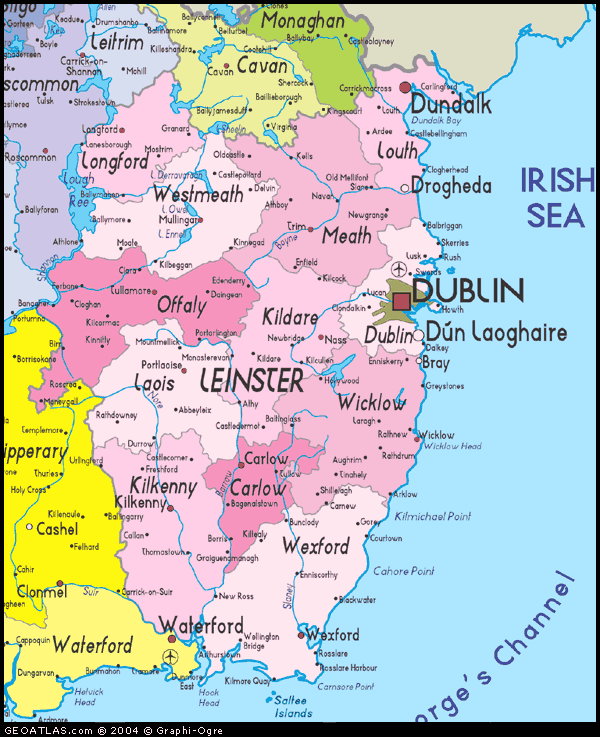
Kells Priory - was founded by Geoffrey FitzRobert in 1193.
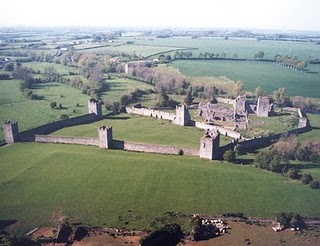 FitzRobert was brother-in-law to Strongbow and the priory succeeded an earlier church which was dedicated to St. Mary, the Blessed Virgin and served as parish church to nearby Kells village.
FitzRobert was brother-in-law to Strongbow and the priory succeeded an earlier church which was dedicated to St. Mary, the Blessed Virgin and served as parish church to nearby Kells village.
During its first century and a half the priory was attacked and burned on three
occasions, firstly by Lord William de Bermingham in 1252, by the Scots army of Edward Bruce on Palm Sunday
1326, and by a second William de Bermingham in 1327. It seems likely then that the walls and fortifications date back to this period of unrest.
In 1324 the Bishop of Ossory Richard de Ledrede paid a lenten visit to the priory. Following an inquisition into a Kilkenny sect of heretics,
Alice Kyteler and William Outlawe were ordered to appear before the Bishop to answer charges of
witchcraft.
Outlaw was supported by Arnold de Paor, Lord of Kells who arrested the Bishop and had him imprisoned in Kilkenny Castle for 17
days. This caused great scandal and on his release the Bishop successfully prosecuted the heretics.
Alice Kyteler fled to England and remained there, Alice Smith also fled, but her mother Petronilla de Meath became Ireland's first heretic to be burned at the stake.
Dissolution of Kells Priory finally took place in March 1540 and the church and property were surrendered to James Butler, 9th Earl of Ormonde.
Kells Priory
Facts, Discussion Forum, and Encyclopedia Article - Kells Priory is one of the largest and most impressive medieval
monuments in Ireland
The Augustine priory is situated alongside King's River beside the village
of Kells
, about 15 km south of the medieval city of Kilkenny.
One of its most striking feature is a collection of medieval tower
houses spaced at intervals along and within walls which enclose a site of
just over . These give the priory
the appearance more of a fortress than of a place of worship and from them
comes its local name of "Seven Castles".
History - Kells Priory was founded by Geoffrey FitzRobert in 1193. FitzRobert
was brother-in-law to Strongbow
Richard de Clare, 2nd Earl of Pembroke
Richard de Clare, 2nd Earl of Pembroke , Lord of Leinster, Justiciar of
Ireland . Like his father, he was also commonly known as Strongbow. He was
a Cambro-Norman lord notable for his leading role in the Norman invasion of
Ireland. He was the son of Gilbert de Clare, 1st Earl of Pembroke and
Isabel...
and the priory succeeded an earlier church which was dedicated to St.
Mary, the Blessed Virgin and served as parish church to nearby Kells village.
During its first century and a half the priory was attacked and burned on three
occasions, firstly by Lord William de Bermingham in 1252, by the Scots army of Edward
Bruce on Palm
Sunday 1326, and by a second William de Bermingham in 1327. It seems likely
then that the walls and fortifications date back to this period of unrest.
In 1324 the Bishop of Ossory Richard de Ledrede paid a lenten visit to the
priory. Following an inquisition into a Kilkenny sect of heretics, Alice
Kyteler and William Outlawe were ordered to appear before the Bishop
to answer charges of witchcraft. Outlaw was supported by Arnold de Paor, Lord of
Kells who arrested the Bishop and had him imprisoned in Kilkenny
Castle for 17 days. This caused great scandal and on his release the
Bishop successfully prosecuted the heretics. Alice Kyteler fled to England and
remained there, Alice Smith also fled, but her mother Petronilla
de Meath became Ireland's first heretic to be burned at the stake.
Dissolution
of Kells Priory finally took place in March 1540 and the church and
property were surrendered to James
Butler, 9th Earl of Ormonde
Kells Monastic Site - The monastery at Kells was probably founded in the 6th century by St Columba. It was refounded in the early 9th century by monks fleeing from Iona after the Viking raids. However Kells itself was plundered at that time and its church destroyed.
A new church was built in 814. In the 12th century the Augustinians established a priory here.
Walter the Templar 1180
Guarnerus
-
Hugh the Templar c.1200 - 10
Henry Foliot
c.1210
Ralph de Southwark 1234
Roger le Waleis 1235
- 50
Herbert de Manchester 1257 - 73
Roger de Glastonbury 1278 - 88
Thomas de Toulouse 1288
Walter le Bachelor* 1295 - 1301
Peter de Malvern 1300
William de Waryne 1302 -
06
Henry Tanet** 1307
- 08
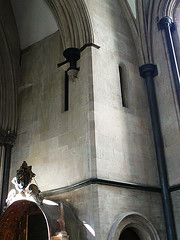 *Walter le Bachelor, was found guilty of financial malpractice and died
(Starved) in the
penitential cell in the Temple Church in London in 1301.
*Walter le Bachelor, was found guilty of financial malpractice and died
(Starved) in the
penitential cell in the Temple Church in London in 1301.
**Henry Tanet was to give evidence against the Order at the trial.
1309 - Gerald fitz Maurice, Lord of Kerry, the last Grand Prior of the Order (of St.John Templars) ( interesting he wasn't mentioned before )
William de Waryne 1302 - 06 - This is interesting in connection to Norfolk....was he a descendant of the 1169 Irish invasion?
William de Warenne, 1st Earl of Surrey - Seigneur de Varennes (Bellencombe, Seine-Maritime, France, 1055 – Lewes, Sussex, 24 May or 24 June 1088[1]) was one of the Norman nobles who fought at the Battle of Hastings and became great landowners in England.
He fought against rebels at the Isle
of Ely in 1071 where he showed a special desire to hunt down Hereward
the Wake who had murdered his brother the year before.[2]
William was
one of the nobles who advised duke William when the decision to invade England
was being considered. He is said to have fought at Hastings,[5]
and afterwards received the Rape
of Lewes in Sussex,[2]
and subsequently lands in twelve other shires. He built castles at Lewes
(Sussex), Reigate
(Surrey), Castle
Acre (Norfolk) and Conisbrough
in Yorkshire.[2]
By the time of the Domesday
survey he was one of the wealthiest landholders in England with holdings in
12 counties
William was loyal to William
II,[2]
and it was probably in early 1088 that he was created Earl
of Surrey.[7]
He died shortly afterwards of wounds he received while helping suppress the rebellion
of 1088. He died in Lewes,
Sussex, and was
buried next to his wife at the Chapterhouse
of Lewes
Priory.
House of Warren
- (de la Varenne, De Garenne, De Warenne, De Warren, Warren) is an Anglo-Norman
comital house
that held extensive lands in France,
England, Wales,
and Ireland. The name
is derived from the town and river of Varenne, Calais
(Pays de Caux), a few
miles from Dieppe
in Normandy.
... Hameline and Isabel's son William Plantagenet de Warren, assumed
before his father's death, the name William de Warren and dropped the
Plantagenet moniker. He accompanied his brother, King Henry II on the
conquest of Ireland in 1169 where his signature appears on a number of charters.
He assisted as sword-bearer in the coronations of his nephews Richard the
Lion-Hearted and John Lackland.
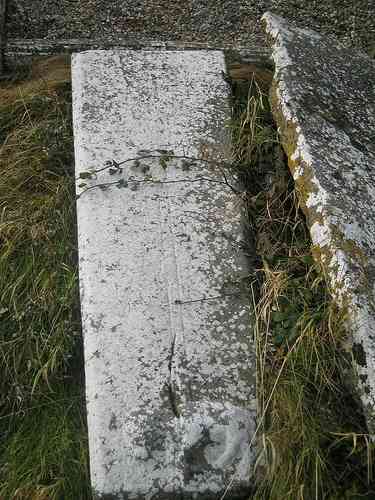 List of places associated with the Knights Templar -
Ireland
List of places associated with the Knights Templar -
Ireland
Ballintemple
House - Ballintemple
started life as a sanctuary for members of the Knights Templar on leave
from the Crusades. The estate formed part of William Marshall's vast
inheritance through his marriage with Strongbow’s daughter in the late 12th
century. 500 years later, the land was granted to Sir Thomas Butler of
Cloghrennan, a first cousin of the “Great Duke” of Ormonde.
Here are a couple of great articles that describes the Black Nobility
origins and how The house of Hanover was able to claim to be House of Windsor.
Also how The FitzGeralds are connected to the Black Nobility etc... (
Also remember the House of Tewdyr (Henry VIII) were descendants of Gerald de
Windsor)
{
Walter fitz-Otho Geraldini married Gladys, daughter of Prince Rywallon of
North Wales. Their sons chose the name de Windsor as their surname from the
estates on which they were born and raised. One of their sons, Gerald de
Windsor, married the famous Nesta, daughter of Rhys ap Tewdyr, Prince of
South Wales.
}
http://www.robertkeating.com/gerardin.htm
The Gherardinis
 Mona Lisa is said to be a
descendant of the Gherardini family.
Mona Lisa is said to be a
descendant of the Gherardini family.
The Keatings sprang from a house whose beginnings, so say the legends, go back
to the days of /troy. Definite records take us back well over a thousand years,
and suppose that the family was indigenous to Italy, being either E/truscan or
Roman.
The Gherardini, the Ancestral family of the Keatings, Fitzgeralds,
Fitzmaurices, Redmonds, Carews, and many other prominent Irish families, were
one of the seigniorial families that fell when the Republic of Florence was
founded.
Its members had estates in various parts of the Florentine territory. In
Florence, their principal residence was near the Ponte Vecchio bridge. Their
tower still exists, being part of the Palazzo Bartolomei.
The first date we have in the family history is 910 A.D. when one Raniero
(Rainier?) was living. The Italian historian Gammurini, says "the
Gherardi were among the most ancient and wealthy families of Tuscany in 900
A.D." Family legend states that Anaes, a survivor of the siege of
/troy, wandered for seven years after it’s overthrow, until he came to what
was then called Latium, (now Italy). He brought with him his father and small
son Ascanius, for whom the province of Tuscany is named. Anaes married the
daughter of King Turnus of Latium, who was killed in battle. Anaes succeeded him
as king of Latium and divided his lands among his descendants. To Gherardo, he
gave the land of He/truria, where Florence now stands.
The family flourished until the year 1125. Then, during a political upheaval,
the patrician families were driven into exile. In order to remain in Florence,
the Gherardini renounced their patrician rank and became mere citizens. Later
they were restored to their ancient honors, became very wealthy, and served the
Republic of Florence both in the senate and on the battlefield. Three were
Consuls of the Republic; others died as leaders of the Republican armies in the
many civil wars. Confiscations and losses during the civil wars impoverished the
Gherardini, and they also suffered much by the des/truction of their property in
the great fire of Florence in 1303. From the 14th century onwards they seem to
have played a smaller part in the history of Florence.
At different times, between 1000 and 1400, individuals of the family
emigrated, passing into France, England, Wales, Ireland, Cracow and the Canary
Islands. Those who stayed in Florence became extinct, as did those in France
and Cracow. It is pleasant to record that the Gherardini of Florence and the
Irish "Geraldines" did not lose touch with each other. There are
records of visits back and forth until the late 1500's.
http://www.geraldini.com/documenti/before-america/Before-America-Part-1.pdf
...
Walter FitzOtho (Geraldini) was a knight in King William's private retinue,
and, when in 1070 William began the building of Windsor Castle, Walter was put
in charge of its defense, and later became the first Constable of Windsor.
Under the Norman kings, as with the kings of France, the Constable was the
principal officer of a royal establishment, and was responsible for the defense
of the establishment, by the knights stationed there. It was this position that
conferred the name 'Windsor' upon Walter’s sons.
The following is an excerpt from an article on the Geraldini family that shows how
the current English Royalty rationalized doing away with the name of Hanover.
It is premised on the vacating of the Windsor baronage by the Geraldinis.
In fact, the male Geraldini heirs continued but they technically did not live
in the Windsor baronage – instead they went to Pembroke.
Windsor Castle continued as a baronage for the Geraldini descendants for
centuries, until it passed out of existence due to lack of male heirs in the
direct line. An interesting footnote is the story of how the current
English royal family, the House of Windsor, took their name from this vacated
baronage. During the first world War, there was enormous anti-German
sentiment in England, and the king wanted to distance himself from the German
House of Hanover, their name at the time.
Since the Geraldini family can be traced as the founders of the House of
Hanover, it was very convenient that (my ancestor) Gerald de Windsor, baron of
England, was related both to the English royal family and the Florentine
Gheradinis, and hence the House of Hanovers.
This provided justification (after much research) for the German House of
Hanover to become the more politically-correct English House of Windsor,
which they remain today.
FITZMAURICE Norman, Welch, and Legendary Ancestors
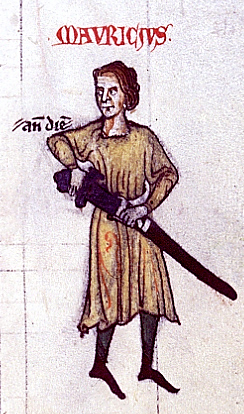 Maurice
fitzGerald de Windsor (Born A.D. 1100; died 1
Sep 1176 at Wexford, Ireland)
Lord of Maynooth and Baron of Naas. The photo at the left is a drawing
of Maurice that his nephew, Giraldus Cambrensis, inserted in the Latin
MS of his Expugnatio Hibernica (Conquest of Ireland) which was completed in A.D.
1189. [Note the red hair on top of his head and the dark mini-beard
on his lower lip.]
Maurice
fitzGerald de Windsor (Born A.D. 1100; died 1
Sep 1176 at Wexford, Ireland)
Lord of Maynooth and Baron of Naas. The photo at the left is a drawing
of Maurice that his nephew, Giraldus Cambrensis, inserted in the Latin
MS of his Expugnatio Hibernica (Conquest of Ireland) which was completed in A.D.
1189. [Note the red hair on top of his head and the dark mini-beard
on his lower lip.]
In A.D. 1168, Dermot MacMorrogh, King of Leinster, driven from his territory by Roderick O'Conor, High King if Ireland, sought assistance from the Norman-Welsh and succeeded in enlisting in his cause Richard de Clare, Earl of Pembroke (called Strongbow). Having reached St. David's, on his way back to Ireland, Dermot was hospitably received by David fitzGerald (son of Gerald of Windsor), Bishop of the diocese. According to Burke's Peerage, the Bishop persuaded his brother, Maurice fitzGerald, and his half-brother, Robert fitzStephen to assist MacMorrough with their forces.
Maurice FitzGerald, Lord of Lanstephan - (c. 1100 – 1 September 1176) was a major figure in the Norman invasion of Ireland.
He was the son of Gerald de Windsor, Constable of Pembroke Castle and Nest, a Welsh princess and former mistress of Henry I. He fought under Robert FitzMartin at the Battle of Crug Mawr in 1136. The exiled High King of Ireland, Dermot MacMurrough (Irish Diarmait Mac Murchada) sought his assistance to regain his position.
Family - The original Earldom of Desmond was based on land holdings in Munster belonging to the descendents of his son Thomas FitzMaurice, father of John FitzGerald, 1st Baron Desmond (died 1261, in Battle of Callann). Of this line are also the Knights of Kerry.
His other son Sir Gerald FitzMaurice, 1st Lord of Offaly (1150–1204), became the ancestor of the Earls of Kildare and modern Dukes of Leinster.
Gerald de Windsor - also known as Gerald FitzWalter, was the nobleman in charge of the Norman forces in Wales in the late 11th century. Notably, he was the progenitor of the FitzGerald dynasty, one of the most celebrated families of Ireland and Great Britain. The FitzGeralds are a Hiberno-Norman or Cambro-Norman dynasty, and have been Peers of Ireland since at least the 14th Century.
Biography - Gerald was the son of Walter FitzOtho, Constable of Windsor Castle, and Gwladys ferch Ryall. Gerald married the Welsh Princess Nesta of Deheubarth, daughter of Prince Rhys ap Tewdwr and Gwladys ferch Rhiwallon, around c. 1095. Gerald held the office of Constable of Pembroke Castle from 1102, was granted the manor of Moulsford in Berkshire (now Oxfordshire) by the King and built a motte and bailey castle at Carew in Pembrokeshire.
Nest ferch Rhys - (died after 1136) was a Welsh princess of Deheubarth who was renowned for her beauty. Nest was the daughter of Prince Rhys ap Tewdwr [ TUDOR ] by his wife, Gwladys ferch Rhiwallon. After her father's death in 1093, Deheubarth was conquered by the Normans and King Henry I of England appointed himself her protector. Nest is thought to have borne him a son, Henry FitzRoy (1103-1158).[1]
Around 1095 King Henry decided to marry Nest to one of his followers, Gerald de Windsor, whom he appointed Constable of Pembroke. Consequently, Nest is the maternal progenitor of the FitzGerald dynasty, one of the most celebrated families of Ireland and Great Britain (they are a Hiberno-Norman or Cambro-Norman dynasty, and have been Peers of Ireland since at least the 14th Century). Nest and Gerald had five children:
The Pembroke Story
- The story of Nest: Princess of Deuhaubarth
She was reputed to be the most beautiful woman in Wales, daughter of
defeated Welsh Prince Rhys ap Tewdwr. At a time when men and their deeds dominated history, she stands out as one of those exceptional women whose story is the stuff of romance.
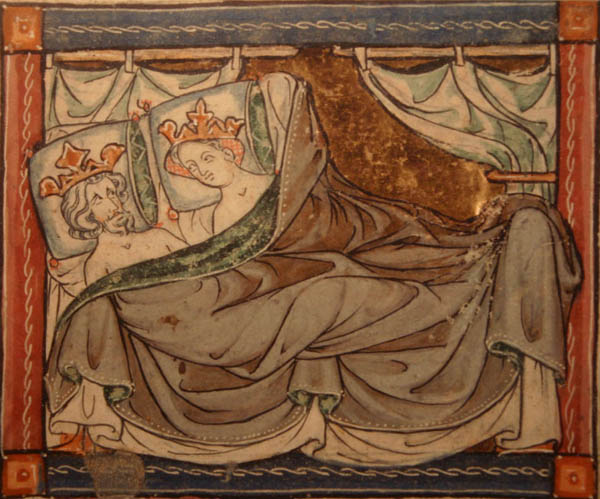 Nesta -
Princess Nesta was a very remarkable woman. She is sometimes referred to
as the "mother of the Irish invasion" since her sons, by various
fathers, and her grandsons were the leaders of the invasion. She had, in the
course of her eventful life, two lovers, two husbands, and many sons and
daughters. Her father is quoted as saying that she had 10 children as a result
of her matrimonial escapades, eight sons and two daughters, among them William
fitzGerald de Windsor. One of her lovers was King Henry I of England.
Some years before she married Gerald, her father, the fierce old Prince of
South Wales, was fighting the English under Henry, (then the Prince and
later King). Henry succeeded in taking the lovely Nesta as hostage. By
this royal lover, she had two sons; Meyler fitzHenry and the celebrated Robert
of Gloucester. It would seem that Gerald, busily engaged in military
business, could have had no peace about his wife, since she was clever as
well as beautiful, and every warrior seems to have fallen in love with
her.
Nesta -
Princess Nesta was a very remarkable woman. She is sometimes referred to
as the "mother of the Irish invasion" since her sons, by various
fathers, and her grandsons were the leaders of the invasion. She had, in the
course of her eventful life, two lovers, two husbands, and many sons and
daughters. Her father is quoted as saying that she had 10 children as a result
of her matrimonial escapades, eight sons and two daughters, among them William
fitzGerald de Windsor. One of her lovers was King Henry I of England.
Some years before she married Gerald, her father, the fierce old Prince of
South Wales, was fighting the English under Henry, (then the Prince and
later King). Henry succeeded in taking the lovely Nesta as hostage. By
this royal lover, she had two sons; Meyler fitzHenry and the celebrated Robert
of Gloucester. It would seem that Gerald, busily engaged in military
business, could have had no peace about his wife, since she was clever as
well as beautiful, and every warrior seems to have fallen in love with
her.
In 1095, Gerald led an expedition against the Welsh on the borders of what is
now Pembrokeshire. In 1100, he went to Ireland to secure for his lord, Arnulf
Montgomery, the hand of the daughter of King Murrough in marriage. He was the
first of the Geraldines to set foot in Ireland, where they were later to rule
like kings. Later, Arnulf joined in a rebellion against the King, was deprived
of his estates and exiled in 1102. Then the King granted custody of Pembroke
Castle to Gerald. Later, he was appointed president of the County of
Pembrokeshire.
But it was Nesta that occupied the center of their stage during their marriage. Her
beauty continued to excite wonder and desire throughout Wales. At Christmas
in 1108, Cadwgan, Prince of Cardigan, invited the native chieftains to a feast
at Dyvet (St. David's). Nesta's beauty was a subject of conversation. She
excited the curiosity of Owen, the son of Prince Cadwgan, who resolved to
see her. She was his cousin, so that the pretense of a friendly visit was easy.
He successfully obtained admission with his attendants into Pembroke Castle. Her
beauty -- it was even greater than he expected -- excited his lust. He
determined to carry her off! In the middle of the night, he set fire to the
castle, and his followers surrounded the room where Gerald and Nesta were
sleeping. Gerald was awakened by the noise and about to discover the cause,
but Nesta, suspecting some treason, persuaded him to make his escape. She pulled
up a board and let her husband escape down a drain by a rope. Then Owen broke
open the door, seized Nesta and two of her sons, and carried them off to Powys,
leaving the castle in flames. Owen had his way with Nesta, (historians say
that one of her ten children was his), though whether she yielded from desire or
force was uncertain. But at her request, Owen hastened to send back the two sons
to Gerald. When King Henry heard of Nesta's abduction, he was furious. He
regarded it as an injury almost personal, since Gerald was not only his steward,
but his particular friend. The abduction of Nesta led to a war, which
resulted in her return to her husband, and Owen fled to Ireland. Gerald
took a conspicuous role in the fighting. In 1116, Henry ordered Owen, who had
returned to Wales, to apprehend Gruffuyd, son of Rhys ap Tewdyr. As he passed
through a wood on his march to join up with the royal forces, Owen seized some
cattle. The owners of the cattle, as they fled, met Gerald, Constable of
Pembroke. Gerald was also on his way to join the royal forces. When the cattle
owners requested his assistance, he was only too delighted to have the
opportunity for revenge for the insult to his honor done by Owen's abduction of
Nesta. He lost no time in pursuing Owen, found him, and a skirmish followed.
Owen was slain, an arrow piercing his heart, and Gerald's honor was avenged.
Gerald died about 1135, leaving three sons and a daughter by Nesta. They
were: Maurice, one of the principal leaders of the Irish invasion in 1169;
William, ancestor of the families of Carew, Grace, Fitzmaurice, Gerald, and the
Keatings of Ireland; David, who became bishop of St. David's; and Angareth, wife
of William de Bari, and mother of the historian, Gerald Cambrensis.
Nesta married again. Her second husband was Stephen, Constable of
Cardigan, by whom she had one son, Robert fitzStephen. Nesta's children and
their descendants constituted a menace to the English rule of Wales. Royal Welsh
blood mingled with the blood of the nobles of Normandy in all the half-brothers,
sons of Gerald of Windsor and Stephen of Cardigan. Bastard or legitimate,
they were turbulent princes in a troubled land. Now fighting the Welsh natives,
now allying themselves with their cousin, Nesta's brother Gruffuyd, the
unconquered Prince of Wales, on whose head Henry had set "a mountain of
gold", they remained a constant source of /trouble to the King, an
ever-present threat to his security.
And so they fought, these Norman barons, and they went on fighting. It was the
able and ambitious Henry II, one of England's really great kings, (the Henry of
"Becket" and "Lion in Winter"), the father of Richard the
Lionhearted and John of the Magna Carta, who was to find a solution. He was
to give these Norman adventurers a free hand in Ireland. It was thus that the
Norman invasion of Ireland came about, and the Geraldines arrived in 1169.
The journey through Wales; and, The description of Wales By Giraldus (Cambrensis), Lewis Thorpe
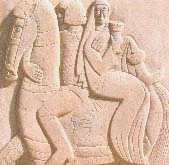 The Journey of Gerald of Wales
- Giraldus Cambrensis or Gerald of Wales was born at Manorbier in
Pembrokeshire around 1147 into a Norman-Welsh family. His father, Gerald de
Windsor had married Nest, the daughter of Rhys ap Tewdwr, Prince of
Deheubarth; the family also claimed a relationship with the family of The Lord
Rhys (Rhys ap Gruffydd). Gerald was educated in Paris; he served as an
administrator of the see of St. David's and as a clerk at the court of Henry II,
accompanied Prince John to Ireland, and traveled with Archbishop Baldwyn
through Wales.
The Journey of Gerald of Wales
- Giraldus Cambrensis or Gerald of Wales was born at Manorbier in
Pembrokeshire around 1147 into a Norman-Welsh family. His father, Gerald de
Windsor had married Nest, the daughter of Rhys ap Tewdwr, Prince of
Deheubarth; the family also claimed a relationship with the family of The Lord
Rhys (Rhys ap Gruffydd). Gerald was educated in Paris; he served as an
administrator of the see of St. David's and as a clerk at the court of Henry II,
accompanied Prince John to Ireland, and traveled with Archbishop Baldwyn
through Wales.
How the Welsh cut their hair, take care of their teeth and shave off their beards
Both the man and women cut their hair short and shape it round their ears.
Like the Parthians the women cover their heads with a flowing white veil, which
sticks up in folds like a crown. Both sexes take great care of their teeth, more
than I have seen in any other country. They are constantly cleaning them with
green hazel twigs, and then rubbing them with woollen cloths until they shine
like ivory. To protect their teeth they never eat hot food, but only what is
cold, tepid, or slightly warm.
The men shave their beards, leaving only their moustaches.
Britannia Sources of British History - Gerald of Wales (1146-1223), in his histories, left an account of the Norman invasion and conquest of Ireland. The Irish conquest was an extension of the conquest of Wales, an activity of Norman lords in the marches who were acting more or less independently of the crown. Once successful, their conquests were adopted by Henry II. It is interesting to note that the Fitzgerald family, represented here by Maurice Fitzgerald, are the ancestors of John F. and Robert Kennedy, and that they make their first appearance in Ireland as Anglo-Norman invaders and conquerors of the native Irish population.
Welsh Princes 2 - ancestors genealogy -
Incidentally, GRUFFUDD ap RHYS and GWENLLIAN are ancestors in the Tudor line of the present British royal family, through both their son the LORD RHYS and their daughter Gwenllian (J. Davies pp.140-1). Henry VII was a great grandson of Maredudd ap Tudur, whose mother descended from the LORD RHYS and father descended from RHYS’S sister Gwenllian.
In fact, Davies also shows that the present Queen descends from GRUFFUDD ap CYNAN in two other ways: through the Scottish kings and through Elizabeth of York, both by way of GRUFFUDD’S son Owain Gwynedd. More recent research, however, shows that the second of these lines is incorrect, as Elizabeth of York’s father Edward IV was illegitimate.
Manorbier Castle - In 1146 Gerald of Wales, the great twelfth century scholar known as Geraldus Cambrensis was born at the castle. As the fourth son of William de Barri, he was related on his mothers's side, to the legendary Welsh princess Nest verch Rhys. Gerald wrote of his birthplace - In all the broad lands of Wales, Manorbier is the most pleasant place by far
A little Welsh History:
Islington,
London - Islington grew as a sprawling village along the line of the
Great North Road ...Islington was originally named by the Saxons
Giseldone (1005), then Gislandune (1062). The name means 'Gīsla's hill'
from the Old English personal name Gīsla and dun 'hill', 'down'.
Islington may have played its own small part in the destruction and conquest by
[Norman] England of north Wales.
In December 1277 the last native prince of Wales, Llywelyn the Last, while
staying in Islington in preparation of his ritual act of homage to the [Norman]
English king, was so heinously offended by the display put on by the locals that
he and his lords resolved never to return and thenceforth to fight England to
the death.[10]
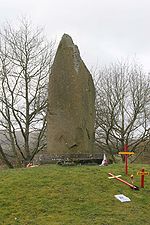 The
Llywelyn Monument at Cilmeri near Builth Wells (Wales)
The
Llywelyn Monument at Cilmeri near Builth Wells (Wales)
Llywelyn,
Our Last Leader—was the last prince of an independent Wales before its
[Norman] conquest by Edward I of England. - 1282 - There are legends
surrounding the fate of Llywelyn's severed head. It is known that it was
sent to Edward at Rhuddlan and after being shown to the English troops based in
Anglesey, Edward sent the head on to London.
In London, it was set up in the city pillory for a day, and crowned with ivy
{i.e. to show he was a "king" of Outlaws} and in mockery of the
ancient Welsh prophecy, which said that a Welshman would be crowned in London as
king of the whole of Britain. Then it was carried by a horseman on the
point of his lance to the Tower of London and set up over the gate. It was still
on the Tower of London 15 years later [2].
1169 - Roberti de Buskevill - Robert of Baskerville
This connects the Baskerville's to the FitzGerald's to Bromholm Priory and the invasion of Ireland.
RootsWeb's WorldConnect Project Lindas Family Tree ( My master file I have no other info )
| ii. | Agnes FitzGerald WINDSOR was born ABT 1092. She married Robert BASKERVILLE, son of Geoffrey Martel DE BACQUEVILLE and Miss DE BACQUEVILLE. He was born ABT 1090. |
Ralph de Baskerville - Ralph II, Robert, Walter - Robert de Baskerville 1149 - Eardisley Herfordshire - 1166 Carta Hugh de lacy - died 1176 - son Ralph died 1186
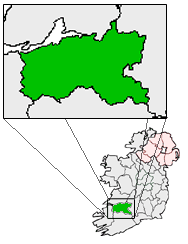 1215
- Geoffrey
de Marisco founded a Commandery of the Knights Hospitallers at Hospital
- parish of Aney Ireland - Hospital,
County Limerick
1215
- Geoffrey
de Marisco founded a Commandery of the Knights Hospitallers at Hospital
- parish of Aney Ireland - Hospital,
County Limerick
1341 - Roger Outlaw, still Prior, Chancellor and Lord Justice of Ireland
died at Aney (Knockainy Co. Limerick)
So Roger wanted to die/be buried back to the beginning, and at the heart of Knights Hospitallers of Jerusalem / Templar home in Ireland - Hospital, Ireland ....
Aney or Knockaney(Knockainy) Civil Parish, Limerick county, Lewis, 1837
ANEY, or KNOCKANEY, a parish, in the barony of SMALL COUNTY, county of LIMERICK, and province of MUNSTER, 3 miles (E.) from Bruff ; containing 4542 inhabitants, of which number, 514 are in the village.
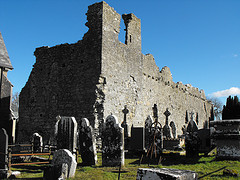 This place, which is situated on the river Commogue,
and bounded on the north by Lough Gur, appears to have been distinguished
at a very early period of Irish history. Its parish church and a monastery, or
college, are said, by ecclesiastical writers, to have been founded about the
time of St. Patrick; but the earliest authentic notice of the place occurs in
941, when a convent for nuns of the order of St. Augustine was founded,
but by whom is not recorded. This establishment, which was called Monaster-ni-Cailliagh
Juxta Aney, and was situated on Lough Gur, was destroyed in the Danish
irruption, but was refounded, in 1283, by a branch of the Fitzgibbon
family, and appears to have subsisted till the dissolution: of the building,
only some small fragments are remaining.
This place, which is situated on the river Commogue,
and bounded on the north by Lough Gur, appears to have been distinguished
at a very early period of Irish history. Its parish church and a monastery, or
college, are said, by ecclesiastical writers, to have been founded about the
time of St. Patrick; but the earliest authentic notice of the place occurs in
941, when a convent for nuns of the order of St. Augustine was founded,
but by whom is not recorded. This establishment, which was called Monaster-ni-Cailliagh
Juxta Aney, and was situated on Lough Gur, was destroyed in the Danish
irruption, but was refounded, in 1283, by a branch of the Fitzgibbon
family, and appears to have subsisted till the dissolution: of the building,
only some small fragments are remaining.
In 1226, a preceptory was founded
here, which subsequently became the property of the Knights of St. John
of Jerusalem; and, in 1349, a friary for Eremites of the order of
St.
Augustine was founded by John Fitzgerald, or, as he was sometimes
called, Fitz-Robert, which, after the dissolution, was granted by Queen
Elizabeth to Edward, John and Mary Absley.
This place was equally celebrated for its numerous stately castles; the most important was a spacious and very strong fortress, erected in 1248 by John Fitzgerald, sometimes called John of Callan, on the western bank of the river Commogue, in which the founder died in 1296; some very inconsiderable fragments only are remaining. In the fourteenth century the same powerful family erected two very strong castles on the shores of Lough Gur, called respectively Doon and the Black castle, to defend the two entrances to Knockadoon, a lofty eminence nearly surrounded by the lake, and by most writers considered as an island. The present castle of Doon, supposed to have been erected on the site of the original by Sir George Boucher, in the reign of Jas. I., is in a very perfect state; but the Black castle is a heap of ruins. A smaller castle was built in the village, soon after the erection of those on Lough Gur, probably by the family of O'Grady, who also built a very extensive castle at Kilballyowen: the former is, with the exception of the roof, in a very perfect state; and the latter has been incorporated with the modern dwelling-house, and contains four rooms in perfect order. Though the surrounding neighbourhood is fertile, and the inhabitants in general opulent, yet the village, which is the property of the Provost and Fellows of Trinity College, and of the Earls of Aldborough and Kenmare, is in a state of neglect and ruin.
ByRoute 6.3 Co. Limerick -- Co. Kerry
Hospital (An tOspidéal) (pop. 1800), a rather confusingly named town, was founded in 1215 as a Commandery of the Knights Hospitallers of Jerusalem. (An alternative but less widely accepted theory connects the town with the Knights Templar). The walls of a large medieval church still stand, and inside can be seen crude effigies of three knights, one in full armour.
Knockainy / Knockainey / Knockaney / Aney is a small village on the River Camoge, with several attractive houses and a couple of good pubs.
According to Lewis (1837), this was the location of an early Christian monastic centre of learning, allegedly founded in the C5th by Saint Patrick, which became an Augustinian convent in 941 AD, was destroyed by Norsemen, and after reëstablishment in 1246 by the FitzGibbon family, survived until King Henry VIII’s 1540 Dissolution of the Monasteries.
Knockainy Castle is a ruined and overgrown C16th Tower House containing a spiral staircase. It is said to have been a FitzGerald stronghold destroyed during the Desmond Rebellions
Knockainy Castle (R680358) is a tower-house about four storys high. Part of the top storey is missing. There are good defensive slits with larger windows at the higher levels. The original entrance is intact and there is a second entrance in the adjoining wall. The third floor ceiling is vaulted and there is a half vault at first floor level. A murder-hole just inside the entrance leads from first floor level and a spiral stairway in the corner leads to the higher levels. A mural passage skirts the top floor room on two sides leading from the stairway to a garderobe. There are a number of good defensive loops in this passage including two circular loops. The windows at the first floor have deep recesses and there may be a small chamber leading off one of them. There are corbels of a bartizan at one corner.
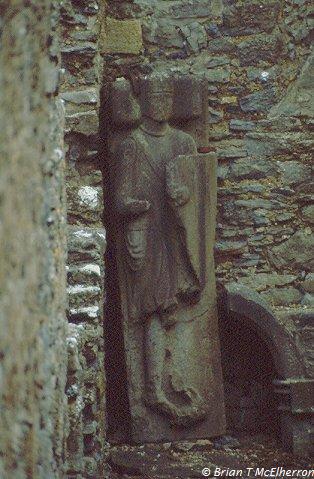 Inside the old church at Hospital
(R706361) are three slabs with effigies. One is very low relief and another is
high relief. The third is high relief with two effigies and very greatly
damaged.
Inside the old church at Hospital
(R706361) are three slabs with effigies. One is very low relief and another is
high relief. The third is high relief with two effigies and very greatly
damaged.
In the gable of the church are a number of carved stones including a good
crucifixion. A fort near Hospital (R710378) is a polygonal structure with low
grassy banks about 25m diameter. A number of large pits just outside may be
modern quarrying. There is some encroachment by a modern house and garden on one
side. About 100m east of the fort is a standing stone (R710379). It is about
2.5m high by 1m wide by 20cm thick and tapering.
A stone circle (R695385) was investigated. It is about 30 ma diameter and has a
bank running through it. The stones in one section are very close together and
many stones are missing. A greatly overgrown fort with a large bank was
inspected (R745386). It is about 30m diameter but close investigation was not
possible due to the dense growth inside. The bank is about 4m high in places and
there is no trace of an outer bank or ditch.
A standing stone (R798394) was inspected. It is about 2m high and less than 1m
square and tapering. On the ground beside it is a large stone with a bullaun. It
stands in the middle of a low circular bank about 15m diameter. Outside this is
a shallow ditch and a large flat area. Beyond this is a second broad shallow
ditch and an outer bank. The total diameter is about 50m. The entrance is on the
east side. On the west and south-west sides are three structures which appear to
be small barrows. One is a well-define, low, circular mound with a ditch. The
second is less well defined and higher and the third is less circular and low.
Hospital Church Geoffrey de Marisco founded a Commandery of the Knights Hospitallers here in 1215. It was dedicated to St John the Baptist and continued in use until the Dissolution in 1541.
Geoffrey de Marisco, Justiciar of Ireland b. Abt 1170 d. Abt 1245 Genealogy 4U
Geoffrey de Marisco was a first-rate scoundrel among those Anglo-Norman
robber-barons who came ostensibly to help Dermot MacMurragh regain his Leinster
kingdom. Geoffrey built the motte, or fortified hill, in Hollywood, County
Wicklow, to defend his first holdings in Ireland.
Also the nephew of the Archbishop of Dublin, and related to King Henry II,
Geoffrey de Marisco was Justiciar (chief governor) of Ireland for eight years
between 1215 and 1228. He was thus well placed to grab a good bit of
Leinster and Munster for himself, snatching equally from Irish chiefs and fellow
Normans alike. He tried to confiscate Terryglass in County Tipperary on the
flimsy excuse that the Norman owner had not fortified it strongly enough, having
built a stone house instead of a castle.
The fact that a child-king -- Henry III -- was on the throne did not exactly
give Geoffrey a free hand in managing the affairs of Ireland, but he took it
anyway. One of his tricks was to keep the taxes he collected in the king's name,
and spend the money, as one chronicler put it tactfully, "more at his own
free will than according to the king's commands." He was eventually sacked.
Later, he got caught with his hand in the Church's till in Limerick and was
excommunicated.
Geoffrey de Marisco, his son William, and three of his nephews were
implicated in a nasty assassination on the Curragh, amidst plots and
counter-plots and treachery at the highest and lowest levels swirling as thick
as Kildare fog.
On 1 July 1231, "Richard Marshall presented himself to the king as the heir
of his brother William Marshall [who had died in early April] ...The king in
reply, by the advice of the justiciary Hubert [de Burgh], told him he had heard
that his deceased brother's wife was pregnant, on which account he could not
listen to his demand till the truth of this matter was discovered." Richard
Marshall was then exiled, accused of associating with the king's enemies in
France.
In 1234, advisers of the king misled him (in their own best interests) into
ordering Geoffrey de Marisco "to seize him [Richard Marshall] if he should
happen to come to Ireland, and bring him, dead or alive, before the king".
Richard Marshall's extensive Irish holdings were promised as a reward to whoever
carried out this task.
On 1 April 1234, Richard Marshall and a handful of men loyal to him, along with
his supposed friend and ally Geoffrey de Marisco and his own soldiers, were
surrounded and outnumbered ten to one by the infamous Hugh de Lacy and a large
number of knights on the Curragh. Marshall was called on to surrender. Geoffrey
advised him against it, and Marshall refused to surrender.
When the fighting started, Geoffrey withdrew with his men, announcing to
Marshall, "My wife is the sister of the noble Hugh de Lacy [some historians
doubt this], and I cannot fight on your side against him with whom I am allied
by marriage."
Marshall said he would "seem a man of a wavering mind" if he
surrendered then, and the battle went on. Marshall killed six of the knights,
and the others feared to approach him. They persuaded foot soldiers to maim his
horse with lances, pitchforks, axes and halberds. As he lay helpless on the
ground in his amour, one of his enemies lifted up his amour and wounded him in
the back. He had fought for ten hours.
Marshall was taken to a supposed friend's castle for medical treatment. He
recovered enough to walk about and play at dice, but after further
"treatment" by a doctor who probed his wounds with a red-hot poker, he
died 16 April.
Afterwards, Richard Marshall was proclaimed "The Knight of the Curragh"
for his heroic stand. Roger of Wendover says of him, "Amongst the sons of
men his person was so beautiful that nature seemed to have striven with the
virtues in its composition."
Geoffrey and his son William were at the same time accused of involvement in the
assassination and fined for siding with the murdered knight against the king.
Both charges seem to have been more or less justified. Afterwards, William began
a vendetta that "disturbed the peace and affected the peace of mind of the
king himself for many years", until eventually he avenged Marshall by
killing the chief assassin.
The de Mariscos were outlawed and became pirates on the Irish Sea. They
concentrated their depredations on shipping to Dublin and Drogheda, which
prompted Dublin to beef up its city walls.
(Isolde's Tower, recently excavated, now covered over and at present being built
on, was part of this improvement in the city's defensive works.)
William was accused -- probably falsely -- of instigating an attempt on the
king's life in 1238. The would-be assassin, who accused him, was torn limb
from limb by horses at Coventry, then beheaded.
In 1242, William was captured -- undoubtedly through treachery -- tried and
condemned. He was then "dragged from Westminster to the Tower of London,
and from thence to that instrument of punishment called a gibbet, suspended on
which he breathed forth his miserable life. After he had grown stiff in
death, his body was let down and disemboweled; his entrails were immediately
burnt on the spot, and his wretched body divided into four parts, which were
sent to the four principal cities of the kingdom, that the sight of them might
strike terror into all beholders. His sixteen accomplices were all dragged
through London at the horse's tail, and hung on gibbets. ... And thus, as before
mentioned, horrible to relate, he endured not one, but several dreadful
deaths."
The 13th-century historian Matthew Paris describes Geoffrey's end:
"About this time [1245], Geoffrey Marsh, a man who had been formerly a
noble, and not the least one amongst the magnates of Ireland, who had incurred
an indelible stain by the treacherous murder of Earl Richard Marshall, and who
was now an exile, and a wretched and proscribed man, having been expelled from
Scotland, banished from England, and disinherited in Ireland, after the
ignominious death of his son and the loss of all his friends, was himself taken
from amongst us; thus finally ending so many deaths by his own."
This is just another interesting story - but does have connections to Ireland and the Hospitaller's (and Roger Outlawe) AND the Templars ... somewhere I found the papers of King Henry III's assassination attempt at Woodstock in 1238
The Marisco's were in charge of Ireland and "owned" Lundy island (between Ireland and Bristol, England) then the King gives Lundy to the Templars and then all hell breaks loose from William de Marisco :
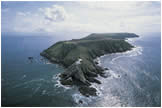 Lundy
Island - Lundy lies off the coast of North Devon, where the
Atlantic ocean meets the Bristol Channel with nothing between it and America, a
granite outcrop, three and a half miles long and half a mile wide.
Lundy
Island - Lundy lies off the coast of North Devon, where the
Atlantic ocean meets the Bristol Channel with nothing between it and America, a
granite outcrop, three and a half miles long and half a mile wide.
History of Lundy - Lundy boasts the world’s oldest operating private postal service - The waters around Lundy Island off the North Devon coast have become England’s first Marine Conservation Zone. This is a direct result of last year’s Marine & Coastal Access Act which aims to protect England’s most important marine habitats and species.
1160 - Lundy was granted to the Knights Templar by Henry II in 1160.
1169 - De
Marisco, Hervey,
one of the most distinguished of the Anglo-Norman invaders of Ireland, nephew
to Earl Strongbow, came over with the first band of adventurers led by Robert
FitzStephen, in May 1169, and received large grants of land in Tipperary,
Wexford, and Kerry - his younger brother was: Geoffrey
1170 - Kells
- Kilkenny - Mills - earliest known one existed around 1170, and was owned by
Baron Geoffrey FitzRobert de Marisco
1215 - Geoffrey
de Marisco founded a Commandery of the Knights Hospitallers at Hospital
- parish of Aney Ireland - Hospital,
County Limerick
1215 - Geoffrey de Marisco was Justiciar (chief governor) of Ireland
for eight years between 1215 and 1228.
1234 - advisers of the king misled him into ordering Geoffrey de Marisco "to seize Richard Marshall if he should happen to come to Ireland, and bring him, dead or alive, before the king". Richard Marshall's extensive Irish holdings were promised as a reward to whoever carried out this task
Geoffrey fled to Clerkenwell - Clerks' Well - Clerkenwell took its name from the Clerks' Well in Farringdon Lane (clerken was the Middle English genitive plural of clerk, a variant of clerc, meaning literate person or clergyman).
The Monastic Order of the Knights Hospitallers of St John of Jerusalem had its English headquarters at the Priory of Clerkenwell.
Clerkenwell Priory - located in Clerkenwell, London. Run according to the Augustinian rule, it was the residence of the Hospitallers' Grand Prior in England, and was thus their English headquarters.
Jordan Briset, a Norman baron, founded the Priory in the reign of Henry II (along with a Benedictine nunnery alongside), and its church was consecrated by the Patriarch of Jerusalem, Heraclius, in 1185. - Heraclius convinced the king to send English troops to a new crusade
Assassination plot ????
Eve de Bermingham, Lady of Offaly - ... Sometime about 1193, she married her first husband, Gerald FitzMaurice, the second eldest son of Maurice FitzGerald, Lord of Lanstephan and Alice de Montgomery. He became the 1st Lord of Offaly by right of marriage to her. Together they had one recorded son:
Gerald FitzMaurice died on 15 January 1204, and was succeeded by their son and heir, Maurice. ...
in 1211, she took a third husband, Geoffrey de Marisco (du Marais), who held the office of Justiciar of Ireland from 1215 to 1221. Her son Maurice would later hold the office from 1232 to 1245. By her third husband, she had at least one son:
Robert de Marisco, married Christiana de Ridelsford, by whom he had a daughter, Christiana de Marisco (1234–1312). The latter was the wife of Ebulo of Geneva, and a lady-in-waiting in the household of Eleanor of Provence, Queen consort of King Henry III of England....
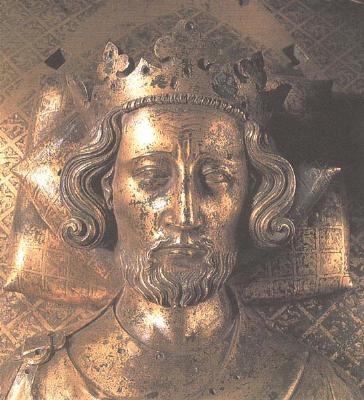 1238
- An attempt was made to kill Henry III by a man who later confessed to being an
agent of the Marisco family - The would-be assassin, who accused him, was torn
limb from limb by horses at Coventry, then beheaded.
1238
- An attempt was made to kill Henry III by a man who later confessed to being an
agent of the Marisco family - The would-be assassin, who accused him, was torn
limb from limb by horses at Coventry, then beheaded.
The de Mariscos were outlawed and became pirates on the Irish Sea. They concentrated their depredations on shipping to Dublin and Drogheda, which prompted Dublin to beef up its city walls.
1242 - William, Geoffrey's son was captured -- tried and condemned. He was then "dragged from Westminster to the Tower of London, and from thence to that instrument of punishment called a gibbet, suspended on which he breathed forth his miserable life. After he had grown stiff in death, his body was let down and disemboweled; his entrails were immediately burnt on the spot, and his wretched body divided into four parts, which were sent to the four principal cities of the kingdom, that the sight of them might strike terror into all beholders. His sixteen accomplices were all dragged through London at the horse's tail, and hung on gibbets. ... And thus, as before mentioned, horrible to relate, he endured not one, but several dreadful deaths."
1245 - Geoffrey [de Maricsco ] Marsh, a man who had been formerly a noble, and not the least one amongst the magnates of Ireland, who had incurred an indelible stain by the treacherous murder of Earl Richard Marshall, and who was now an exile, and a wretched and proscribed man, having been expelled from Scotland, banished from England, and disinherited in Ireland, after the ignominious death of his son and the loss of all his friends, was himself taken from amongst us; thus finally ending so many deaths by his own."
Lundy - is the largest island in the Bristol Channel, lying 12 miles (19 km) off the coast of Devon, England, approximately one third of the distance across the channel between England and Wales. It measures about 3 miles (5 km) by 0.75 miles (1.2 km) at its widest.[3] Lundy gives its name to a British sea area and is one of the islands of England.[4]
The name Lundy is believed to come from the old Norse word for "puffin island" (Lundey), lundi being the Norse word for a puffin and ey, an island,[7] although an alternative explanation has been suggested with Lund referring to a copse, or wooded area.[8]
According to genealogist Edward MacLysaght the surname Lundy is from Norman de la Lounde, a name recorded in medieval documents in counties Tipperary and Kilkenny in Ireland.[9]
Lundy was granted to the Knights Templar by Henry II in 1160. The Templars were a major international maritime force at this time, with interests in North Devon, and almost certainly an important port at Bideford or on the River Taw in Barnstaple. This was probably because of the increasing threat posed by the Norse sea raiders; however, it is unclear whether they ever took possession of the island.
Ownership was disputed by the Marisco family who may have already been on the island during King Stephen's reign. The Mariscos were fined, and the island was cut off from necessary supplies.[15] Evidence of the Templars' weak hold on the island came when King John, on his accession in 1199, confirmed the earlier grant
Marisco family - Marisco Castle
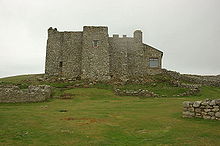 In
1235 William de Marisco was implicated in the murder of 2 a messenger of Henry
III.[17]
In
1235 William de Marisco was implicated in the murder of 2 a messenger of Henry
III.[17]
Three years later, an attempt was made to kill Henry III by a man who later confessed to being an agent of the Marisco family. William de Marisco fled to Lundy where he lived as a virtual king. He built a stronghold in the area now known as Bulls' Paradise with 9 feet (3 m) thick walls.[16]
In 1242, Henry III sent troops to the island. They scaled the island's cliff and captured William de Marisco and 16 of his "subjects". Henry III built the castle (sometimes erroneously referred to as the Marisco Castle) in an attempt to establish the rule of law on the island surrounding waters.[18]
William De Marisco was hung drawn and quartered for plotting to kill King Henry III in the 13th century
1235 - Henry Clement was a clerk of Maurice FitzGerald. He was murdered in the spring of 1235
The
Golden Falcon - ("The Marisco Family of Lundy &
Ireland" - E. St. John Brooks, Journal; of Royal Society of Antiquaries
of Ireland Vol. 61. pp. 22-38 & 89-112 (1931) quoted in "Islands -
Lundy").
The de Mariscos were first recorded in Lundy during the reign of Stephen
(1135-54). The Orkneyinga Saga mentions a freeman of Wales who founded an
impregnable fortress there in 1148 which probably belonged to the de Mariscos.
In 1163 Prince Madoc or another messenger from North Wales sought their help
against Henry I but they were loyal.
They held the island from 1154-1166 for the 5th part of a knight's fee from
Bernard Newmarch and from Henry de Newmarch in 1154-66. Bernard Newmarch became
lord of Brecon and a de Marisco, Sausmarez or Somery may have followed him to
Wales (probably Robert de Sumeri who was in Glamorgan). The surname Dumaresq
survives in Brecon.
Their stronghold was in the area west of the High Street rickyards in Bull's
Paradise.
Their
coat of arms were "gules, a lion rampant, argent" and that of William
de Marisco "gules, a lion rampant sable, langued gules" which may mean
they were royal bastards (or alternatively descended from Charlemagne). The
potential assassin of King Henry was described "he bore the royal mark on
his shoulder."
In 1155 Henry II demanded the return of royal lands granted away by Stephen to
the Mariscos. In 1160 he tried to grant the land to the Templars but the de
Mariscos would not allow it and were fined in 1194-5.
In 1199 King John confirmed the Templars' grant and they had to pay rent for the
de Marisco lands in Somerset "as long as William de Marisco shall holde the
island of Lunde against the king's will and theirs". In 1202 the Templars
still owed rent and William de Marisco was using Lundy as a pirate base for
raids on North Devon.
He was given charge of the king's galleys, becoming Admiral of the Fleet to
during the quarrel with the church and the Templars were forced to relinquish
their lands. In 1216 William sided with the Scots and the French against the
kung and was captured by the English whilst serving with the French fleet. In
1271 Henry III declared an amnesty and restored Lundy to William who died in
1225. He was succeeded by his son Jordan.
William's brother Geoffrey was Hugh de Lacy's brother-in-law and justiciar of
Ireland at the time of his death and had a son, also named William.
Geoffrey was loyal to Henry III when earl Richard Marshal of Ireland rebelled.
This occurred because Gilbert Basset, lord of Wycombe, Buckinghamshire and
castellan of Devizes castle was disseised by the king of a Wiltshire manor in
favour of Peter de Mauley, former castellan of Corfe Castle. Richard Marshall
upheld Gilbert's claim and went to Ireland to defend his lordship and castle of
Leinster where he was attacked and died of his wounds.
Geoffrey de Marisco was accused of luring his friend the marshall to his
death and his son William began a feud which lasted for many years. Geoffrey
and his son came under suspicion of complicity after the rising was put down. He
was fined 3,000 marks and his relatives were fined as well and imprisoned but released
in 1234 after the king had seized 3 of their castles as pledges for future
fidelity. Geoffrey and William went to London to vindicate themselves and
met an enemy Henry Clement who was murdered.
William was suspected and fled to Lundy;
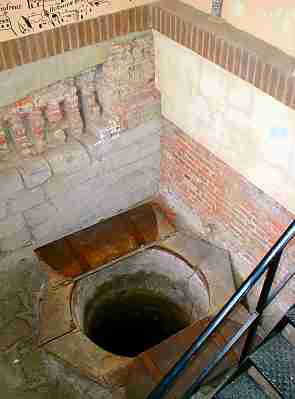 Geoffrey
took refuge in Clerkenwell.,
the site of a holy well. He was outlawed, disinherited and expelled from
England, Ireland and Scotland in 1238 after having plotted to kill the king at
Woodstock and died in France in 1245.
Geoffrey
took refuge in Clerkenwell.,
the site of a holy well. He was outlawed, disinherited and expelled from
England, Ireland and Scotland in 1238 after having plotted to kill the king at
Woodstock and died in France in 1245.
William, son of Jordan de Marisco, inherited Lundy in 1234 and
disassociated himself from his cousin. Jordan also incurred the king's
displeasure in 1281.
Geoffrey's son William then turned pirate and allied himself with Alexander,
king of Scots against Henry. An attempt was made on Henry III's life
allegedly by William's agents.
He was captured in 1242 by William Bardolf, a Norfolk baron, taken to
Bristol, then to the Fleet and Newgate in London. He was hanged, drawn and
quartered on 25.6.1242, a punishment "invented for the express benefit of a
William Maurice, the son of a nobleman who was convicted not of treason but of
piracy" ("A history of capital punishment" - John Lawrence). He
was the first traitor to meet his death in such a manner.
The de Mariscos got the king to recognise their right to Lundy. Stephen,
son of Robert de Marisco died in 1374 without heirs and Lundy passed to William
Montacute, earl of Salisbury after Stephen had waived his claim.
1238 - Assassination
attempt on Henry III at Woodstock was foiled because he was sharing the
bed with Eleanor of Provence in HER chamber...(they were married!)
Eleanor of Provence - was Queen consort of England as the spouse of King Henry III of England from 1236 until his death in 1272...she was very much hated by the Londoners. This was because she had brought a large number of relatives with her to England in her retinue; these were known as "the Savoyards", and they were given influential positions in the government and realm. On one occasion, Eleanor's barge was attacked by angry citizens who pelted her with stones, mud, pieces of paving, rotten eggs and vegetables....Eleanor was married to King Henry III of England on 14 January 1236. In 1272 Henry died, and her son Edward, who was 33 years old, became Edward I, King of England. She remained in England as Dowager Queen, and raised several of her grandchildren—Edward's son Henry and daughter Eleanor, and Beatrice's son John.
Devonshire Characters and Strange Events-The Pirates of Lundy
Two engravings and a plan of the castle, as it was in 1775, appear in Grose's Antiquities. He thus describes it:—
We come now to the attempted assassination at Woodstock Palace. Matthew Paris tells the story under the date 1238, in the reign of Henry III.
 "On
the day after the Nativity of St. Mary, a certain learned esquire came to the
King's Court at Woodstock pretending that he was insane, and said to
the King, 'Resign thy kingdom to me'; he also added, that he bore the
sign of royalty on his shoulder. The King's attendants wanted to beat him,
and drive him away from the royal presence, but the King interfered, saying, ’Let
the madman rave—such people's words have not the force of truth.'
"On
the day after the Nativity of St. Mary, a certain learned esquire came to the
King's Court at Woodstock pretending that he was insane, and said to
the King, 'Resign thy kingdom to me'; he also added, that he bore the
sign of royalty on his shoulder. The King's attendants wanted to beat him,
and drive him away from the royal presence, but the King interfered, saying, ’Let
the madman rave—such people's words have not the force of truth.'
In the middle of the night, however, the same man entered the King's bedchamber window, carrying an open knife, and approached the King's couch, but was confused at not finding him there. The King was, by God's providence, then sleeping with the Queen. But one of the queen's maids, Margaret Bisett, was by chance awake, and was singing psalms by the light of a candle (for she was a holy maid and one devoted to God), and when she saw this madman searching all the private places to kill the King, she was greatly alarmed, and began to utter repeated cries. At her cry the King's attendants awoke, and leaped from their beds with all speed, and running to the spot, broke open the door, which this robber had firmly secured with a bolt, and seized him, and notwithstanding his resistance, bound him fast.
He, after a while, confessed that he had been sent to kill the King by William de Marisco, son of Geoffrey (or Jordan) de Marisco, and he stated that others had conspired to commit the same crime. On learning this, the King ordered him to be torn limb from limb by horses, at Coventry."
The evidence incriminating William de Marisco was clearly worthless. If the would-be assassin had not been insane he would not have asserted a claim to the crown and drawn attention to himself before making the murderous attempt. De Marisco had nothing to gain by the King's death, and he may certainly be acquitted of participation.
William fled to Lundy, "impregnable from the nature of the place, and having attached to himself many outlaws and malefactors, subsisted by piracies, taking more especially wine and provisions, and making frequent sudden descents on the adjacent lands, spoiling and injuring the realm by land and by sea, and native as well as foreign merchants. Many English nobles, having learnt how that the said William and his followers could not be surprised save by stratagem, apprised the King that the securing of this malefactor must be effected not by violence, but by craft. The King therefore ordered his faithful subjects to exert themselves strenuously in order to capture him and relieve their country."
Nothing, however, was done for four years, during which the piracies continued. There was this excuse for De Marisco, that as the island grew neither corn nor wine, he was dependent on the mainland or on merchant vessels for his subsistence. As all those on the mainland were on the look-out to capture him as the supposed mover of the plot to kill the King, he was forced to live by piracy.
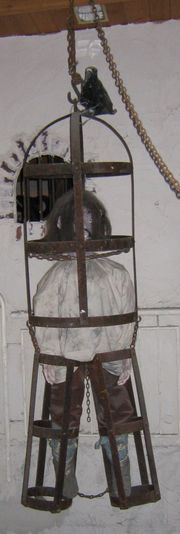 In 1242, William of Worcester informs us, he was caught: how, he does not say,
save that it was by surprise. "He was thrown into chains, and he and
sixteen accomplices were condemned and sentenced to death. He was executed at
the Tower on a gibbet with special ignominy, his body suspended in a sack, and
when stiff in death, disembowelled, his bowels burnt, and his body divided into
quarters."
In 1242, William of Worcester informs us, he was caught: how, he does not say,
save that it was by surprise. "He was thrown into chains, and he and
sixteen accomplices were condemned and sentenced to death. He was executed at
the Tower on a gibbet with special ignominy, his body suspended in a sack, and
when stiff in death, disembowelled, his bowels burnt, and his body divided into
quarters."
After the execution of Sir William, his father, Geoffrey (or Jordan) fled to France, and the island was then seized by the King, who appointed to it governors. But in 1281 Lundy was again granted to a Marisco, Sir William, son of Jordan, another of the progeny of old Geoffrey. He died in 1284, and his son John in 1289, leaving Herbert as his son and heir. But Edward II granted the island to the elder Despenser, and Herbert was unable to obtain possession of it. He died in 1327, and from that date no more is heard of the Mariscoes in connexion with the island.
From their time, however, other pirates obtained a footing on it. In the days of Henry VIII a gang of French pirates, under their captain, De Valle, seized Lundy and waylaid the Bristol traders, but the Clovelly fishermen made an expedition against them, burnt their ship, and killed or made prisoners of the whole gang.
A few years later, Lord Seymour, High Admiral of England, uncle of Edward VI, was charged, among other misdemeanours, with trying to get hold of Lundy, "being aided with shipps and conspiring at all evill eventes with pirates, (so that) he might at all tymes have a sure and saufe refuge, if anything for his demerites should have been attempted against him." He was executed, having refused to answer the charges made against him.
Gibbet - A gibbet is a gallows-type structure from which the dead bodies of executed criminals were hung on public display to deter other existing or potential criminals. To gibbet a criminal is to display the criminal on a gibbet. [1] This practice is also called "hanging in chains".
Marsh Families (Marisco) DNA Project - Heraldry
The rampant lion: In heraldry, the Lion represents "deathless courage".
The Norman de Marisco (Marsh) family (also known as de Merc, and variant spellings) which arrived in England with William the Conqueror, used a rampant lion on their coats of arms.
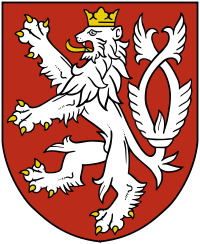 Often, the lion was white, on a red shield. The Morris and Marris/
Maris families which by traditions also descend from the de Mariscos, use
rampant lions in various forms even today. A number of Mark/ Marke families
possibly have common origins to the de Merc/ de Marisco families, and some of
these use a rampant lion. Although some Marsh families by tradition have
descended from the de Mariscos, I am not aware of any Marshes currently using a
rampant lion. The rampant lion is a very common feature appearing on many
Coats of Arms of apparently unrelated families of different surnames. The
horse head by contrast, is much less commonly used by other surnames.
Often, the lion was white, on a red shield. The Morris and Marris/
Maris families which by traditions also descend from the de Mariscos, use
rampant lions in various forms even today. A number of Mark/ Marke families
possibly have common origins to the de Merc/ de Marisco families, and some of
these use a rampant lion. Although some Marsh families by tradition have
descended from the de Mariscos, I am not aware of any Marshes currently using a
rampant lion. The rampant lion is a very common feature appearing on many
Coats of Arms of apparently unrelated families of different surnames. The
horse head by contrast, is much less commonly used by other surnames.
The rampant lion is suggested by some to derive from possible family
connections, and/ or political connections, to the early English royal family,
but some say it may trace further back from a use of that symbol in
the region of Flanders, or even tracing further back to Charlemagne, or
King David. See: Armorial
of the Holy Roman Empire
Annie's Hearth - Dame Alice Kyteler - Born [ Jose de Keteler died ] 1280 in Kyteler's House, Kilkenny, Ireland, the only child of a wealthy banker
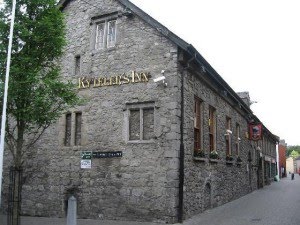 Kyteler's
Inn is located
in the heart of Kilkenny City. Established in 1324 [? Kyteler was brought to
trial ], this popular Kilkenny pub and restaurant has plenty of history
to offer.
Kyteler's
Inn is located
in the heart of Kilkenny City. Established in 1324 [? Kyteler was brought to
trial ], this popular Kilkenny pub and restaurant has plenty of history
to offer.
The original owner of this Inn was Dame Alice le Kyteler whom was born in Kilkenny in the year 1263
[? I have her father died 1280 when she was 10, so 1263 may be when her father
moved there and 1270 when she was born ] . In her time she gained much
notoriety not least because she acquired four husbands and a considerable
fortune. Her enemies eventually conspired to accuse her of witchcraft and have
her burned at the stake. It is now generally accepted that the charges
against Dame Alice and her associates were trumped up but what is on record
as been certainly true is that Kyteler's Inn was "a place of merrymaking
and good cheer".
In 1317 Outlaw was granted the fee-farm of Chapelizod. Which was then added to the lands of the monastery
Chapelizod - (Irish: Séipéal Iosóid, meaning "Iseult's Chapel") is a village in Dublin, Ireland. It lies in the wooded valley of the River Liffey at the start of the Strawberry Beds, below the Phoenix Park. The village is rumoured to be the burial site of Iseult of Ireland. It is under the governance of Dublin Corporation.
Journal of the Royal Society of Antiquaries of Ireland - THE KILKENNY ARCHAEOLOGICAL SOCIETY VOL. XLV. CONSECUTIVE SERIES VOL. V. SIXTH SERIES 1915
The use of a counter seal, which was common in the thirteenth century, was doubtless to prevent the removal of a seal from one document and its transfer to another for fraudulent purposes ; when the wax was impressed on one side only it was possible to cut away the face of the seal with a heated knife, but when the wax was impressed on both sides this process was rendered considerably more difficult.
Dr Lyon also drew a seal of a subsequent Prior of Kilmainham, that of Roger Utlaugh. The original seal was attached to a deed dated 1318 A.D., and a small portion (about a third) still remains. Dr Lyon's drawing shows that the design of the seal, which is circular, and measures 1| inches in diameter, is the same as the last, but the inscription is different ; it reads : — + SIGILL : CONVENT • DOMUS HOSPITALIS IN HIBERNIA
(Plate XIII, fig. 3). The counterseal is also circular, and measures 1 inch in diameter. The device is a shield bearing the arms of the Order of the Knights of St John of Jerusalem, silver a cross gules. The shield has a bird like a swan on each side, and is enclosed in an ornamental panel (Plate XIII, fig, 4). The inscription reads + si • pris rogeri outlawe.
^ Roger Utlaugh was one of the most distinguished of the Priors of Kilmainham : he combined his office with that of Lord Chan- cellor of Ireland, and was for a time Lord Deputy as well."^ His seal is therefore of considerable interest.
There is a description of the seal of Wilham FitzThomas, another Prior of Kilmainham^ in the British Museum Catalogue of Seals, vol. iv, p. 717. The seal is stated to be imperfect, the device being a shield of the arms of FitzThomas, a saltire charged with a cross paty, and a helmet surmounted by the Agnus Dei. It is dated 1430 a.d. The last seal to be described is that of the Official of Glendaloch, which was attached to a deed dated 1314 a.d. A fragment of the original seal still remains. Dr Lyon's drawing shows that it bore the effigy of St Kevin represented habited as an abbot with amice, alb, dalmatic, and chasuble, holding a crozier turned outwards in his right hand and a book in his left. It is possible that the curious, flat cap on the Saint's head is an error in the drawing, and that in the original seal it was an exaggerated tonsure. The seal is pointed- oval in shape, and measures 1| by | inches. The inscription round the edge of the seal had evidently disappeared at the time Dr Lyon made his drawing, but in the body of it can be read the Saint's name beat : keivinvs (Plate XI, fig. 5).
A history of Roger Outlawe (without the Kyteler history):
Inchicore.info ...
Of course the site of The Royal Hospital at Kilmainham had a previous
significant history. It was the site of St. Mhaighneann’s Church in the
7th century. Brian Boru assembled his army at Kilmainham prior to the Battle of
Clontarf. Later this was the same site where the Strongbow built a monastery
for Knights Templars in 1174 after the Norman invasion.
The monastery/hospital was used as a seat of power for the English Government
in Ireland for 300 hundred years. The Priors of Kilmainham often held the
highest civil offices in the “Kingdom.” Parliaments were often held in the “Castle”
of Kilmainham.
In 1309 The Knights Templar were suppressed by the Pope, The King of
France and the King of England. All of their very valuable properties throughout
Ireland were given to The Knights Hospitallers.
The Knights Hospitaller then transferred their head-quarters from Wexford to
Kilmainham. The Priors of Kilmainham continued to command significant civil
power and were relied upon by the Kings and Queens of England to maintain their
control in Ireland up until the reign of Henry VIII.
The most famous Prior of Kilmainham was Roger Outlaw. He became prior of
Kilmainham in 1316.
In 1317 Outlaw was granted the fee-farm of Chapelizod. Which was then added to the lands of the monastery.
Also in 1317 Outlaw convened a Parliament at Kilmainham at which he
secured the release of Richard De Burgo, Earl of Ulster who had been imprisoned
by the Mayor and Commons of Dublin on suspicion of aiding the Scottish invasion
of Ireland by Robert de Bruce.
In 1318 Outlaw was made Lord Treasurer of Ireland where upon he bound himself
and his successors to pay £300 a year to the Archbishop of Dublin to exercise
Episcopal jurisdiction in Rathmore and neighbouring churches.
Also in 1318 King Edward recognising the success of Outlaw’s organisational
skills and the charitable work of the monastery granted that all deoudands
accruing to Ireland for the ensuing year should be paid towards the support of
the poor flocking to Kilmainham.
In 1326 Outlaw granted Nickolas de Rosse a pension of twenty shillings of silver
for defending the monastery in courts. Also in the same year he gave
accommodation to William De Wideworth in Dublin near Bothe street (later
Fishamble Street). Outlaw played an important part in securing peace between
many various factions in Ireland. A vicious civil war broke out among the Norman
barons with the Fitzgeralds, the Butlers and the Berminghams on one side and the
De Burgs and the Le Poers on the other.
The native Irish took the opportunity to engage in attacks on both sides as
their common enemies. Their activity compelled the barons to feel that they were
engaged in a work of self-extermination.
Roger Outlaw addressed himself with creditable zeal to establish peace among
them and the native chieftains having gained no advantages of a permanent
character from their constant struggles offered to submit themselves to the
government and Outlaw thus prevailed.
Outlaw petitioned the King to have the whole body of English law applied to
Ireland. An offer of eight thousand marks was offered but the English
administration rejected the offer in the belief that the condition in Ireland
was in too great a state of ferment and commotion. The Irish chieftains were
most anxious to secure the protection of the common law but the English invaders
wanted the freedom to annex the property of the native Irish.
Outlaw had to contend with newly created Earls of Desmond, Ormonde, Ulster,
Meath, Kildare, Leix, Kilkenny, Wexford and Carlow as well as the native Irish
chieftains the O’Neills, the McCartans, O’Moores, O’Dempseys, O’Connors,
O’Tooles, the McMurroughs and the O’Riellys. Outlaw travelled to London on
two occasions in 1323 and again in 1331 to report to the King on the state of
things in Ireland. In 1331 he assisted the king’s finances with a loan of £200.
In 1331 the King again affirmed the possessions of Kilmainham under Roger
Outlaw. The King also bestowed the church of Ballyogarry on Kilmainham. In 1333
Outlaw bestowed a pension of £40 on William Kardleby in recognition of goods
and services provided to Kilmainham. In 1334 Outlaw granted John Joyce Chaplin,
the church of St. Michael in Wexford with all the profits therefrom for life at
an annual rent of four marks of silver, all taxes and burdens to be duly paid.
In 1335 Outlaw gave a pension of 13 shillings and 4 pence to Adam de Kingston
and he granted the church of Ballyogarry to Bartleby Clake in lieu of a pension
of £40. He also granted to Hammond de Lee the post of park-keeper of Kilmainham
with a daily allowance of a white loaf, a household loaf, a flagon of best ale,
a dish of meat from the kitchen and a half a mark of silver annually for the
purchase of shoes. Outlaw gave numerous similar pensions to various persons
connected with the monastery and to persons outside of it.
In 1338 the King rewarded Roger Outlaw for his long service and loans of money
with custody of the manor at the Salmon Leap in Leixlip. In 1341 Roger Outlaw,
still Prior, Chancellor and Lord Justice of Ireland died at Any (Knockainy Co.
Limerick) “ a prudent and upright man who by his care and the special favour
and licence of the king, had procured many lands, churches and rents for order
of the Knights Hospitallers.”